
























A RETIRED oil refinery manager from Pembrokeshire has been jailed for eight years after being found guilty of sexually abusing four young girls — the youngest just five years old.
Robert Jeffrey Hughes, 74, from Spittal, near Haverfordwest, carried out the abuse more than two decades ago while holding a senior position at one of the county’s oil sites
The offences came to light in 2022 when one of the victims, now an adult, found the courage to report what had happened. Police enquiries then uncovered three further victims, all of whom were under 13 at the time of the abuse.
At Swansea Crown Court, the women — now in their twenties and thirties — described how Hughes’s actions had scarred their lives. One told the court
Tom Sinclair editor@herald.email
she grew up believing men could not be trusted, while another said years of anxiety and depression could be traced back to the abuse she suffered as a child.
Sentencing, Judge Paul Thomas KC condemned Hughes as “a paedophile, and an arrogant one at that,” saying he had hidden “behind a façade of respectability” for years. The judge said it was regrettable that Hughes had not admitted his crimes sooner, sparing his victims the ordeal of giving evidence.
Hughes will serve half of his eight-year sentence in prison before being released on licence. He will remain on the sex offenders register for life.

A WEST Wales man who was being held on remand at Swansea Prison has died while awaiting trial for arson.
Mark Waterman, aged 54, of Parc Graig Glais, Upper Queens Road, Aberystwyth, was found dead at HMP Swansea on 7 October 2025. His death has been confirmed by the Prisons and Probation Ombudsman, which has launched a formal investigation into the circumstances.
Waterman had appeared before Aberystwyth Magistrates’ Court on 11 June, charged with arson with recklessness as to whether life was endangered following an incident at his home address on 9 June. The case was sent to Swansea Crown Court for trial, and he was remanded in custody pending that hearing.
Court records show that Waterman entered no plea at his first appearance. The prosecution was led by CPS Wales (South West), with magistrates Mrs S Lees and

factors that may have contributed to his death. A coroner’s inquest is expected in due course.
confirmed the news on social media and said: “Another death at HMP Swansea! We’ve only just found out about it but it’s PPO confirmed. Mark Waterman died on 7 October 2025 –this is the fourth death at Swansea this year. That hasn’t happened in decades.”
Mr S Noden presiding over the brief hearing.
The Ombudsman’s investigation will examine the care Waterman received while in custody and any
“Th IS h AS n’ T h APPE n ED I n decades”
Wales’ most prominent prison campaigner, Zackery Lee Griffiths,
HMP Swansea, a Category B/C men’s prison on Oystermouth Road, has a troubled history of deaths in custody. In recent years inspectors and coroners have repeatedly warned of risks to new and vulnerable inmates in the early days of custody. Across England and Wales, deaths in custody have hit record levels this year — 401 in the twelve months to June 2025, including 86 self-inflicted deaths. Campaigners say the rising toll at Swansea is a stark sign that Wales’ prisons are under severe strain.
The Herald understands that Waterman’s case will also be subject to a coroner’s inquest in due course.
MILFORD hAVEn will observe this year’s Remembrance period with a series of events organised by the Town Council and the Royal British Legion.
The first gathering will take place on Sunday, November 2, with a Dedication Service at the Memorial Gardens. Attendees are asked to arrive for 10:30am, with the service beginning at 11:00am. Crosses will then be placed in the special area in front of the First World War Memorial Plaque.
The main Remembrance Day Service will be held on Sunday, November 9, at 11:00am at the Cenotaph on Hamilton Terrace. The parade will assemble at the
Tom Sinclair editor@herald.email
Town Hall from 10:30am, stepping off at 10:45am to proceed to the Cenotaph for the service and act of remembrance.
Finally, on Tuesday, November 11, representatives of the Royal British Legion will assemble outside One Stop Haven Stores, 85 Charles Street, at 10:45am to lead the traditional Two Minute Silence at 11:00am, marking the Eleventh Hour of the Eleventh Day of the Eleventh Month. Residents are encouraged to attend and pay their respects to all those who gave their lives in service.







CARMARThEnShIRE man has been jailed for three years after police found cocaine and cannabis hidden in a Llanelli storage locker — part of a drugs line which The herald understands stretched into Pembrokeshire.
Matthew Davies, known locally as ‘Hillbilly’, of Dwyfor, Llanelli, was arrested after Dyfed-Powys Police officers
uncovered a secret lock-up containing thousands of pounds worth of drugs and cash.
During the search, officers discovered multiple bags of cocaine and cannabis along with cash bundles totalling £46,000, which Davies has now been ordered to hand over under the Proceeds of Crime Act.
The discovery followed a routine patrol in Llanelli which drew officers’ attention to suspicious activity at the site. Subsequent searches linked Davies to the lock-up and to a series of incriminating text messages discussing drug deals across south-west Wales.
He was charged with possession of cocaine and cannabis with intent to supply, and pleaded guilty before the court.
The officer leading the investigation, Detective Constable Steve Thomas, said: “The quick-thinking of our PCSOs ultimately led us to Davies, allowing us to take another criminal off our streets.
“I hope this case shows that we have the means and motivation to investigate and prosecute those who disregard public safety by dealing drugs in our community. We will continue to take robust action against drugs in our area.”
Davies was sentenced to three years in prison and ordered to forfeit £46,000 of drug-related cash.
Dyfed-Powys Police said the case demonstrates their ongoing commitment to tackling drug crime across west Wales — including Pembrokeshire, Carmarthenshire and Ceredigion.

ThE A48 between Carmarthen and Pont Abraham is once again under scrutiny after new figures revealed that the number of crashes on the dual carriageway has increased over the past year — despite repeated calls and Welsh Government studies aimed at improving safety.
The 15-mile stretch, which links Carmarthen with the M4, has long been regarded by drivers as one of the most dangerous roads in Wales. With a 70mph limit, multiple junctions, and several points where traffic can legally cross the central reservation, the road has become a regular scene of collisions — often involving serious injury.
Figures released by Dyfed-Powys Police under the Freedom of Information Act show 186 recorded collisions between August 2024 and July 2025. That represents a rise from the 169 crashes logged in the previous twelvemonth period.
The most hazardous section remains the four-mile stretch between Cross Hands Roundabout and Pont Abraham, where 40 incidents were recorded. Pont Abraham Roundabout itself saw 31 collisions, more than triple the total for the same area the previous year.
While there were small improvements in other sections – such as a slight reduction in crashes at Llanddarog and Pensarn – the overall picture shows the problem worsening rather than improving.
Over the past decade, more than 1,400 crashes have occurred on the A48 between Pensarn and Pont Abraham.
Caerfyrddin MP Ann Davies, who lives near the route, described the figures as “heartbreaking and alarming”.
“As someone who travels the A48 daily, I see the dangers first-hand,” she said. “These numbers underline what local people already know – that this road remains unsafe and urgently needs attention. Road safety is not just about policy; it’s about protecting lives.”
Adam Price MS, who represents Carmarthen East and Dinefwr, said the findings raise serious questions about the effectiveness of previous government studies.
“For a road of this length to see such a high number of collisions is completely unacceptable,” he said. “The Welsh Government’s previous safety review clearly hasn’t delivered results. Lessons need to be learned quickly, and we need to see tangible change.”
The Welsh Government has confirmed that the first phase of new safety measures – between Cross Hands and Llanddarog – is due to begin in March next year. Planned work

includes changes to central reservation crossings and the closure of unsafe laybys.
A government spokesperson said: “We take road safety extremely seriously and continuously review collision data provided by the police to inform future improvements. The latest figures will be considered carefully as part of that process.”
Local residents have been warning
for years that the road layout is unsuitable for the volume and speed of modern traffic. The A48’s combination of high-speed carriageways, bus stops, and uncontrolled turn-offs has created a mix that campaigners say would not be tolerated on newer trunk routes.
In 2018, six separate crashes were recorded on the A48 in a single day, prompting one county councillor to call the road “a disgrace”.
Seven years later, drivers say little has changed — except that the statistics keep getting worse.
A 29-year-old Pembrokeshire postman has been ordered off the roads after driving from a wedding reception when he was over twice the legal drink-drive limit.
Thomas Calveley had attended a wedding party at the Gelli Fawr Hotel, Newport, on the night of October 13. But when an argument broke out between Calveley and his partner, Calveley made the foolish decision to drive off.
“He decided to remove himself from the situation after the argument broke out, and perhaps this was the correct thing to do,” his solicitor, Peter Tarr, told Haverfordwest magistrates this week after Calveley pleaded guilty to drinkdriving.
“But what was not the correct thing to do was jump in his car and drive off.”
Shortly after leaving Gelli Fawr, Calveley’s Seat Ibiza was involved in
a road traffic collision near Pontfaen.
Police were called, and shortly after they arrived at the scene, Calveley identified himself to the officers.
“He admitted crashing the vehicle and said he’d consumed alcohol earlier that evening,” said Crown Prosecutor Chris Evans.
Subsequent breath tests showed Calveley had 77 mcg of alcohol in his system. This was almost twice over the legal limit, which is 35.
Meanwhile Peter Tarr informed the magistrates that as a result of the incident, Calveley has resigned from his employment as a postman.
Calveley, of Howarth Close, Milford Haven, was disqualified from driving for a total of 20 months and fined £120. He was ordered to pay £85 court costs and a £48 surcharge.

A teenager from h averfordwest has been banned from driving after admitting a drink-driving offence.
Tony Lovell, aged 19, of St Marks
Close, Merlins Bridge, appeared before Haverfordwest Magistrates’ Court on Monday (Oct 27).
He pleaded guilty to driving a motor vehicle while over the legal
alcohol limit on May 31 this year. A second, related charge of being in charge of a vehicle while above the limit was dismissed after no evidence was offered by the prosecution.
Magistrates imposed an obligatory driving disqualification, giving credit for his early guilty plea. He was also ordered to pay prosecution costs.


PLAnS to house asylum seekers at military bases in England and Scotland have prompted renewed discussion in Pembrokeshire over whether the former Penally Camp could once again be brought into use.
The UK Government confirmed this week that around 900 asylum seekers will be moved to Cameron Barracks in Inverness and Crowborough Training Camp in East Sussex from the end of next month. The move is part of a wider effort to cut the soaring cost of hotels by using larger, contained accommodation sites.
Defence Minister Luke Pollard said the government was testing whether military sites could provide “adequate accommodation” and reduce public opposition to hotels. However, MPs on the Home Affairs Committee have warned that barracks could prove even more expensive once maintenance and security costs are included.
Although Penally Camp has not been
mentioned in the latest announcement, the decision has led to speculation that other former military facilities across the UK could be reconsidered in future.
hOTEL SySTEM BRAnDED A ‘mess’
Around 30,000 asylum seekers are currently being housed in hotels at an estimated cost of several billion pounds a year. Some contracts are reported to run until 2036, locking taxpayers into long-term deals that were originally intended for short-term use.
Reports from Westminster have revealed that many of these contracts were awarded without open scrutiny, with hotel operators making millions of pounds while local councils struggle to cope with the social impact. Critics have called the system “a mess”, accusing

successive governments of losing control of spending and failing to create humane, efficient alternatives.
Penally Camp, near Tenby, was used by the Home Office in 2020 and 2021 to house several hundred male asylum seekers. The decision proved highly contentious, with local residents complaining of poor communication and inadequate facilities.
A joint inspection by Her Majesty’s Inspectorate of Prisons and the Independent Chief Inspector of Borders and Immigration later found the camp was “unsuitable” for long-term accommodation, citing overcrowding, poor hygiene, and lack of access to healthcare and legal advice.
The Home Office closed the site in spring 2021 and returned it to the Ministry of Defence. Since then, it has been earmarked for potential redevelopment, including possible housing.

Pembrokeshire councillors say they have not been informed of any plans to reopen the camp but have urged the government to clarify its position. One senior councillor told The Herald: “Residents still remember the disruption and uncertainty caused by the 2020 decision. It would be completely unacceptable to use Penally again in that way.”
The Welsh Government has also expressed concern about the suitability of former military sites, insisting that asylum accommodation must be safe, humane, and supported by local services.
A Home Office spokesperson said: “We keep all accommodation options under review but there are currently no plans to reopen the Penally site.”
The use of military sites marks a reversal of previous government policy. Ministers had earlier pledged to end the use of barracks following criticism from inspectors and human rights groups. The change reflects growing pressure to reduce hotel spending and address record asylum backlogs.
While there are no indications that Penally is under consideration, if the government were to revisit the site, substantial upgrades would be required to meet current standards. Even so, refurbishing existing facilities could prove cheaper than sustaining thousands of people in hotels for years to come.
The Herald understands there are currently no Welsh sites under active review as part of the Home Office’s new accommodation programme.



WALES is benefiting from more than £1.1 billion in defence investment, backing thousands of skilled jobs and helping to drive economic growth across the nation.
According to the UK Government’s new Defence Footprint report, the Ministry of Defence spent £1.1 billion with industry in Wales over the past year — supporting 3,900 jobs in sectors ranging from advanced manufacturing to cyber
security.
That equates to £340 of defence spending per person in Wales, underlining the major contribution the sector makes to the Welsh economy.
The investment forms part of the Government’s historic commitment to increase defence spending to 2.6% of GDP by 2027, with an ambition to reach 3% in the next Parliament. Ministers say the spending not only strengthens
national security but acts as a powerful engine for economic growth across all regions of the UK.
The Secretary of State for Wales, Jo Stevens, said: “The defence industry is a vital part of the Welsh economy and provides thousands of high-quality jobs across every part of the country.
Each of the Ministry of Defence’s top five suppliers has a footprint here, so Wales is well placed to benefit from the
UK Government’s increase in defence spending.
Our number one mission is kickstarting economic growth, and by investing in the defence sector we are safeguarding our national security, creating new jobs and putting more money in people’s pockets.”
Minister for Defence Readiness and Industry Luke Pollard MP added: “Our record uplift in defence investment will ensure our forces have the kit they need to fight, ensuring we are secure at home and strong abroad.
By making defence an engine for growth across the country, the defence dividend is benefitting Welsh jobs, communities and businesses.
Wales’ expertise in advanced manufacturing and cyber security makes it an essential part of Britain’s defence ecosystem.”
Defence work in Wales spans armoured vehicle production, high-end drone manufacturing, and digital defence innovation, with major operations from Anglesey to Cardiff. The sector supports both direct employment and hundreds of supply-chain businesses, boosting local economies and providing long-term, highvalue careers.
The UK Government says this investment demonstrates its “Plan for Change” in action — protecting the nation while delivering prosperity for Welsh communities.
A MAn from Carmarthen has been fined for a series of shop thefts and a criminal damage offence.
Robert Wilson, aged 34, of no fixed address, appeared before Haverfordwest Magistrates’ Court on
Monday (Oct 27).
Wilson pleaded guilty to three counts of theft from shops and one count of criminal damage relating to incidents in Carmarthen between September 30 and October 25, 2025.
The court heard that he was involved in repeat shoplifting offences in the town and caused damage to property valued under £5,000 during the same period.
Magistrates imposed fines totalling
£440, which included £120 for each theft and £80 for the damage offence.
Dennis Davies prosecuted for CPS Wales (South West), and Katy Hanson acted as duty solicitor for the defence.
MILFORD hAVEn Town Band will host a Remembrance Concert at St katharine and St Peter’s Church on Friday (nov 7) at 7:30pm, bringing the local community together through the power of music to honour those who served and sacrificed for their country.
The annual concert is a highlight of the town’s Remembrance calendar and will feature a stirring programme of traditional hymns, reflective pieces, and uplifting favourites performed by the award-winning brass ensemble.
Band members have been rehearsing for weeks to prepare a special evening that blends solemn remembrance with a celebration of unity and hope. The concert will include musical tributes to the fallen, as well as popular arrangements designed to inspire reflection and gratitude among audience members of all ages.
The event takes place inside the historic St Katharine and St Peter’s Church, which provides a fitting setting for remembrance with its rich acoustics and atmosphere of peace and reverence.
A spokesperson said said: “This concert means a great deal to us and to the community. It’s our way of saying thank you to those who served, and of ensuring their memory continues through music. We hope as many people as possible will join us on the night.”
Admission is free, with a collection taken in aid of the Royal British Legion Poppy Appeal and local veterans’ charities. Doors open from 7:00pm, and early arrival is recommended.
For more information, visit the Milford Haven Town Band Facebook page or contact the organisers directly via the event listing.

The evening promises to be a moving tribute and a chance for residents to come

A GRIEVInG mother has spoken publicly on BBC television about her anguish and fury on the fourth anniversary of the River Cleddau paddleboarding tragedy which claimed four lives in October 2021.
Teresa Hall, whose only daughter Morgan Rogers, 24, died in the disaster, said she remains “in torture every day” and cannot forgive the “arrogant and reckless” decisions that led to the deaths.
Speaking in a BBC Wales interview broadcast this week, she said: “No parent should ever have to bury their child because of something so unnecessary. Anger doesn’t even come close. I go over that morning every single day if only I’d told her not to go.”
Morgan was one of eight paddleboarders who set out that morning on what was meant to be a guided river adventure organised by Nerys Lloyd, 39, a former police officer and owner of Salty Dog Co Ltd. Lloyd led the trip despite severe weather warnings, heavy rain, and fast-rising river levels on the
Cleddau.
The group launched from Haverfordwest and made their way downstream towards the weir near the town centre. Witnesses later told investigators that the river was in flood and “boiling with turbulence.”
Ignoring the conditions, Lloyd instructed those following her to “keep to the centre” and attempt to descend the fish pass at the middle of the weir. What followed became the worst paddleboarding accident in UK history.
As the first boards went over, three women Morgan Rogers, Nicola Wheatley, 40, and Andrea Powell, 41 were dragged beneath the surface by the powerful recirculating current, known as a “hydraulic jump,” which trapped them under the water.
Another instructor, Paul O’Dwyer, 42, from Port Talbot, saw what was happening


life, she’s destroyed my children’s family life,” he told the BBC. “Their mother will never come back.”
Nicola, a dental hygienist and mother of two from Swansea, had joined the weekend tour as a treat for herself after recently turning 40. Only weeks earlier, her husband and mother had bought her a paddleboard for her birthday.
On the morning of the trip, he had warned her that the weather looked terrible. “But she told me not to worry,” he said. “She said the instructors knew what they were doing.”
and rushed to help. He climbed out of the riverbank to try and reach them, then jumped back in but was immediately pulled over the weir and killed.
Passers-by raised the alarm at around 9:02am, throwing lifebuoys into the swollen water as emergency services raced to the scene. Police, firefighters, coastguards and RNLI crews worked frantically to recover the group.
Andrea Powell was pulled out alive but later died in hospital six days later. The bodies of Nicola Wheatley and Morgan Rogers were recovered nearby, while Paul O’Dwyer’s body was located downstream by a Coastguard helicopter.
An investigation by the Marine Accident Investigation Branch (MAIB) later concluded that the tragedy was “entirely preventable.” The report condemned Lloyd’s “catalogue of errors,” stating that she had shown “an abysmal approach to safety management” and failed to heed basic weather or river warnings.
In June this year, Lloyd was jailed for ten years and six months after being found guilty of gross negligence manslaughter. Sentencing her at Swansea Crown Court, the judge said she had displayed “arrogance and complacency” and had shown a “cavalier disregard for the welfare of others.”
For the victims’ families, the years since have brought little comfort.
Teresa Hall recalled the moment police officers came to her home to tell her that Morgan was believed to be among the dead. “I just remember screaming,” she said. “Then at the hospital, I went over to her and shook her, trying to wake her up. You can’t accept that your child’s gone.”
For Darren Wheatley, the widower of health worker Nicola, the loss remains unbearable. “She’s destroyed my family
In court, prosecutors said Lloyd had ignored Met Office yellow warnings and an Environment Agency alert for rising river levels. They told how she insisted on continuing the trip even after co-instructor O’Dwyer expressed concerns about the conditions.
The MAIB’s findings led to renewed calls for tighter oversight of adventure tourism businesses, with outdoor instructors across Pembrokeshire urged to undergo extra training in risk assessment and flood awareness.
Local paddleboard groups have since worked closely with the RNLI and Natural Resources Wales to install clearer signage around known hazards on the Cleddau and to warn visitors not to approach the weir during high water.
A spokesperson for Haverfordwest Town Council said: “The events of October 2021 left a deep mark on our community. Lessons have been learned, and everyone involved in water sports locally is determined to ensure such a tragedy never happens again.”
Four years on, floral tributes still appear each autumn at the riverside. Locals remember Morgan as “full of energy and laughter,” Nicola as “a devoted mother,” Andrea as “kind-hearted and strong,” and Paul as “the man who ran towards danger to help others.”
Standing beside photographs of her daughter this week, Teresa Hall said she wanted to keep her memory alive. “She was my only child,” she said quietly. “The light in my life has gone. I just want people to remember them — and to make sure no-one ever risks lives like that again.”
The River Cleddau disaster remains a defining moment in Pembrokeshire’s recent history a day when joy turned to horror on the water, and a reminder of the fine line between adventure and tragedy.
A WOMAn from haverfordwest has appeared in court accused of dealing drugs and possessing criminal property.
Samantha Whelton, aged 38, of Heol Derwen, Merlins Bridge, appeared before Haverfordwest Magistrates’ Court on Monday (Oct 27).
She faces two charges – possession of a controlled drug with intent to supply, and acquiring, using or possessing
criminal property – both alleged to have taken place on October 26, 2025.
No pleas were entered at the hearing. Magistrates sent the case to Swansea Crown Court for trial, due to the seriousness of the offences.
Whelton was remanded in custody until her next appearance.
Dennis Davies prosecuted for CPS Wales (South West), and Katy Hanson appeared for the defence.

A WOMAn from haverfordwest has been sentenced for a series of assaults and damage offences, including attacks on an emergency worker.
Sarah Moane, aged 35, of Three Meadows, Haverfordwest, appeared before Haverfordwest Magistrates’ Court on Monday (Oct 27).
The court heard that Moane admitted assaulting an emergency worker, assault by beating, and criminal damage to
property on June 30 and July 1 this year. She pleaded guilty to the charges in July, when the case was adjourned for reports.
Two further assault charges relating to incidents in September were later dismissed after no evidence was offered by the prosecution.
Magistrates imposed a term of imprisonment, taking into account her guilty pleas and the aggravating factor that one of the victims was an emergency worker.



A ‘one-off mistake’ has resulted in a 12-month driving ban for a 40-yearold haverfordwest motorist after she was caught driving with two illegal drugs in her system.
Kerrie Whitehead, 40, was approached by officers on the afternoon of July 26 after she was seen driving her Vauxhall Mokka into the Tesco car park in Haverfordwest.
“The officers could smell cannabis and a roadside drugs swipe came back positive,” Crown Prosecutor Nia James told Haverfordwest Magistrates this week.
Further blood tests carried out at the police station showed that Whitehead had 9.8 mcg of Delta-9tetrahydrocannabinol, and 59 mcg of the cocaine derivative benzoylecgonine in her system. The legal limits are 2 and 10 respectively.
Whitehead, of Augustine Way, Haverfordwest, pleaded guilty to both
charges of drug driving.
“This is a woman of completely clean character who has never been in the courts before,” said her solicitor, Tom Lloyd. “This was a one-off mistake.”
Tom Lloyd’s comments were endorsed by probation officer Julie Norman.
“The cannabis and the cocaine derivative were both found in her blood, but she’s normally someone who can keep herself out of trouble,” she said.
“She uses cannabis mainly at night, to help her to sleep, and she used the cocaine a few days before being stopped by the police.”
Whitehead was sentenced to a 12-month community order during which she must carry out 50 hours of unpaid work and complete ten rehabilitation activity requirement days. She was disqualified from driving for 12 months and ordered to pay a £114 court surcharge and £85 costs.

A court has heard details of what was described to the court as ‘a most unsophisticated theft’ after a 42-year-old walked into his local Spar, helped himself to Budweiser beer and promptly walked out without paying.
Pleading guilty to theft before haverfordwest magistrates this week was Robert Parker, formerly of the Silverdale Lodge, johnston, but currently of no fixed abode.
“This was the most unsophisticated theft where the defendant simply walked into the Spar store in Monkton, helped himself to the Budweiser, and then left,” said Crown Prosecutor Chris Evans.
Mr Evans went on to say that Parker has a total of 157 previous offences, 68 of which are for crime offences.
For the latest theft offence committed on October 12, Parker was fined £40 and ordered to pay £12.75 compensation to the Spar Stores, Monkton. He was also ordered to pay £85 court costs and a £16 surcharge.

A SERIAL shoplifter has been sentenced after admitting a string of thefts from stores in both England and Wales.
Luke Sumner, aged 23, of no fixed address but formerly of Brunel Way, Shrewsbury, appeared before Haverfordwest Magistrates’ Court on Monday (Oct 27).
Sumner pleaded guilty to multiple counts of theft from shops in Carmarthen, Llangunnor, and Shrewsbury between July and October 2025, along with criminal damage and one count of affray.
The court heard that Sumner stole items from several retail outlets over a three-month period, with offences recorded on July 20, 23, 27, 28, 29,
August 1 and 3, October 11, 14, and 25.
He also attempted to steal from another store on July 23, and caused damage valued under £5,000 on the same day.
Magistrates were told that Sumner had previously been remanded in custody on related matters, and that a conditional discharge was imposed for his latest Carmarthenshire offences.
Katy Hanson represented the defendant, while Dennis Davies prosecuted.
Sumner was released from custody on the discharge order but remains subject to further proceedings relating to the earlier affray and robbery charges listed under separate case numbers.

FIREFIGhTERS from Mid and West Wales Fire and Rescue Service have been crowned Best Breathing Apparatus (BA) Team and awarded the prestigious title of Overall Best Team at the national Breathing Apparatus Challenge (nBAC).
The event, held over the weekend of October 12, 2025, at the Fire Service College in Moreton-in-Marsh, Gloucestershire, saw 19 fire and rescue services from across the UK compete in realistic and high-pressure firefighting scenarios.
The winning Mid and West Wales team — Dominic Norcross (Officer in Charge), Lee Rees (Driver / Fireground Setup), Luke Fisher and Tim Frost (BA Team), and Morgan Lewis (BA Entry Control Officer) — impressed judges with their exceptional teamwork, technical precision, and commitment to safety.
Sponsored by Draeger UK and supported by The Fire Fighters Charity, the competition promotes excellence in BA procedures and incident command. Each five-person crew was challenged to tackle a simulated property fire, with just 30 minutes to bring it under control and rescue casualties.
Teams were marked by National Assessors on:
• Incident Command
• Fireground Procedures
• Entry Control
• BA Wearing and Procedures
Mid and West Wales Fire and

Tom Sinclair editor@herald.email
Rescue Service excelled across all categories, particularly in Command and Control, technical knowledge, and practical firefighting skills.
Manager
said: “This achievement reflects the dedication, professionalism, and rigorous training of our firefighters. To be recognised as the best among such strong competition is a testament to the high standards we uphold in Mid and West
Wales. We’re incredibly proud of the team’s success.”
The NBAC remains a vital platform for improving firefighter safety, sharing best practice, and strengthening collaboration across UK fire services. For more information, visit www. nbac.co.uk.
A court has heard how a Pembroke Dock woman dealt with her grief after losing her long-time partner of 11 years, by resorting to shoplifting.
“This was her way of coping,” said probation officer Julie Norman during the sentencing of 44-year-old Lisa Stewart at Haverfordwest magistrates court this week.
“In January of this year her partner of 11 years passed away with a terminal illness. As a result, she was feeling very depressed, she wasn’t herself, so she stole the items.”
The first offence took place on May 1 when CCTV cameras showed Stewart entering the Asda supermarket in Pembroke Dock and walk out carrying three bottles of Jamesons Whiskey valued at £75. Five days later she returned to
Asda, and once again was filmed by security cameras stealing meat products to the value of £482.80.
On two further occasions she was seen entering the Pembroke Dock branch of Boots and make off with a quantity of razors, valued at £134.35.
This week Stewart, of Truscott House, London Road, Pembroke Dock pleaded guilty to four charges of theft.
After considering the mitigation, magistrates sentenced Stewart to a 12-month community order during which she must carry out 15 rehabilitation activity requirement days.
She was ordered to pay £557.80 compensation to Asda and £134.35 compensation to Boots. She must also pay a £114 court surcharge and £85 costs.

DRuG dealer Austin hockey has admitted supplying MDMA, cannabis and hallucinogenic substances in Pembrokeshire.
The 32-year-old, from Acresbush Close, Bishopsworth, Bristol,
appeared before Swansea Crown Court where he faced six drug-related charges.
Hockey was found to have been in possession of MDMA, cannabis and 4-bromo-2,5-
dimethoxyphenethylamine – known as 2C-B – with intent to supply in west Wales on December 1, 2023.
He also admitted being concerned in the supply of the same three drugs between August 1 and December 2, 2023.
Judge Huw Rees ordered a presentence report and remanded Hockey in custody ahead of sentencing on November 14.

FIShInG communities in west Wales are set to benefit from a major new investment, as the uk Government launches a £360 million Fishing and Coastal Growth Fund –with £18 million allocated to Wales.
The funding, which will be managed by the Welsh Government, aims to revitalise the fishing industry, modernise equipment and vessels, and strengthen coastal economies such as those around Milford Haven, Fishguard and Saundersfoot.
The initiative forms part of the UK Government’s Plan for Change, designed to boost jobs and growth in traditional maritime regions while ensuring long-
Tom Sinclair editor@herald.email
term sustainability for the sector.
focus on modernisation and SkILLS
The fund will be targeted towards projects that strengthen the fishing fleet through new technology, training, and improved infrastructure. In Pembrokeshire, this could include upgrades to harbour facilities, investment in aquaculture, and support for young people entering the industry.
The Welsh Government will decide how to distribute its share of the money, allowing investment to be tailored to local priorities. It follows previous support from the Welsh Marine and Fisheries Scheme, which helped local seafood producers and small fishing firms recover from the pandemic and adapt to post-Brexit trade changes.
“VITAL BOOST FOR COASTAL jOBS”
Secretary of State for Wales Jo Stevens said: “Wales’s coastal communities are hugely important, and this £18 million allocation will help deliver
a bright, sustainable future for the fishing industry and those who live on our coast by improving infrastructure, creating jobs and boosting investment in skills.”
Fisheries Minister Dame Angela Eagle added: “The grit and determination of fishers throughout the UK brings the best seafood to our dining tables and across the world. This fund will revitalise the fishing sector and coastal communities right across the UK, helping the sector thrive for generations to come.”
Fishing has long been part of Pembrokeshire’s coastal identity — from Milford Haven’s dockside trawlers to smallscale shellfish and crab fisheries along the Cleddau and beyond. Local industry representatives say the funding could provide a much-needed lifeline as the sector adapts to modern environmental and economic challenges.
Mike Cohen, Chief Executive of the National Federation of Fishermen’s Organisations, said: “Fishing remains full of potential. Well managed, and with the right support, it can be an engine to drive sustainable growth all around our coastline.”
The UK Government also confirmed it plans to begin negotiations for a new trade agreement with the EU to reduce export barriers for seafood producers, making it easier to sell Welsh fish and shellfish to European markets.
If delivered effectively, the new funding could help ensure Pembrokeshire’s fishing ports continue to play a key role in the region’s economy — from local processors to exporters supplying some of the finest seafood in Europe.
miLford HaVen toWn counciL has expressed its sadness following the recent passing of former Mayor john Morgan.
Mr Morgan, who served as Mayor in 1978–1979 and again in 1987–1988, devoted much of his life to the town and its community. A long-time resident of Romilly Crescent, Hakin, he was especially passionate about the Hakin and Hubberston area, where he worked tirelessly to support local causes and residents.
A spokesperson for Milford Haven Town Council said: “John Morgan dedicated his life to Milford Haven and its people. His service and commitment left a lasting legacy in our town, and he will be greatly missed.”
The council extended its deepest condolences to Mr Morgan’s family and loved ones, inviting residents to share their memories and tributes in his honour.

A haverfordwest factory worker has narrowly escaped a custodial sentence after being caught driving when he was almost four times over the legal drink-drive limit.
Police received calls from members of the public who were concerned at the manner in which a Volkswagen Tigros was being driven on the A40 in the early hours of Monday, October 13.
When police apprehended the vehicle, they discovered its driver was Polish factory worker Sebastian Poznanski. The 44-year-old provided a positive roadside breath test while further breath tests carried out at the police station showed he had no less than 137 mcg of alcohol in his system. The legal limit is 35.
“Various members of the public had contacted the police because of the manner in which the vehicle was being driven,” Crown Prosecutor Chris Evans told Haverfordwest magistrates this week.
“It was swerving all over the road.”
As a result of the extremely high reading, magistrates requested an all-options probation report prior to sentencing from probation officer Julie Norman.
“It was the early hours of a Monday morning and the defendant was driving to work at a factory in Haverfordwest,” Ms Norman told the Bench.
“He’d drunk alcohol the previous day and assumed he would be ok to drive to work. But clearly he wasn’t fit to be on the road.”
Ms Norman said that Posnanski, of Priory Street, Carmarthen, regularly works 12-hour days at the factory. “He doesn’t have a drink problem, but he works very long hours during the week,” she said.
Poznanski was disqualified from driving for 32 months and was ordered to complete 150 hours of unpaid work during his 12 month community order.
“Your high reading means that a custodial sentence could have been imposed,” said the presiding magistrate when imposing sentence.
He was ordered to pay a £114 court surcharge and £85 costs.



PEMBROkE & MOnkTOn Local history Society will launch an inspiring new project celebrating the vital role of women in local history at its next meeting on Saturday, november 8, in Pembroke Town hall.
The initiative aims to honour three remarkable women connected with Pembroke — Princess Nest, Isabel de Clare, and Margaret Beaufort — whose lives span the Middle Ages, from the Norman invasion to the founding of the Tudor dynasty.
Chairman Linda Asman said the project seeks to redress the imbalance in historical commemoration: “So little attention is given to the vital contribution of women, and so few statues are erected to them. We want to put this right.”
A presentation will be given by
sculptor Harriet Addyman, best known for her acclaimed statues of Henry VII and William Marshal. The meeting will also discuss plans for a wider statue and arts trail throughout the town.
Doors open at 10:00am, when visitors can enjoy coffee and homemade cakes, followed by the presentation at 11:00am. Admission is free, though donations and raffle proceeds help cover the society’s costs.
Although the museum is closed to the public during the winter months, it will open specially for the Saturday morning talks.
For more information, visit www. pembrokeandmonktonhistory.org.uk or follow the society on Facebook. Queries can be sent to pembrokehistory@live. co.uk, or contact 07584 429224.
A Pembrokeshire motorist who was seen by members of the public driving his Ford Focus in ‘an erratic manner’ through a haverfordwest residential area was found to be over twice the legal drug-driving limit.
Police were called to the road leading through Hawthorn Rise, Haverfordwest on August 5 following reports made by members of the public that the vehicle had been seen driving in an erratic manner. There they discovered the car being driven by Harry Evans, 29, of Camuset Close, Hakin.
“What makes this particularly worrying is the fact that he was stopped nine miles from his home address,” Crown Prosecutor Chris Evans told Haverfordwest magistrates this week.
Subsequent blood tests carried out at the police station showed that Evans had 5.3mcg of Delta-9-tetrahydrocannabinol in his system. The legal limit is 2.
After pleading guilty to the drug-driving offence, Evans was disqualified from driving for 12 months. He was fined £120 and ordered to pay £85 court costs and a £48 surcharge.
A CARMARThEn man has appeared in court accused of assaulting and intentionally strangling a woman in haverfordwest.
Michael Sudbury, aged 50, of no fixed abode but previously of Llangunnor Road, Llangunnor, appeared before Llanelli Magistrates’ Court on Wednesday (Oct 23).
He faces two charges relating to an alleged incident on October 22 — one of common assault and another of intentional strangulation, both said to involve the same complainant, a female.
Sudbury pleaded not guilty to both offences. He was remanded on conditional bail, which prohibits him from entering the village of Llechryd and from contacting Ms Everson directly or indirectly. He must also report to Swansea Police Station every Tuesday and Friday between 12:00pm and 2:00pm.
The case was adjourned for trial, which is due to take place at Haverfordwest Magistrates’ Court on December 8 at 12:00pm.


A SECTIOn of the roadside wall on Solva hill has collapsed, prompting urgent safety concerns this afternoon (Tuesday).
The incident occurred on the main
road through Solva, where part of the stone wall overlooking the water has given way. Local residents are currently managing traffic at the scene while awaiting the arrival of police.

taken today show a significant section of the wall missing, with rubble and debris falling toward the river below. The damage poses a risk to vehicles travelling along the narrow stretch of road, which remains open at this time.
Solva Community Council issued a warning on social media, advising motorists to “proceed with caution” and to avoid the area if possible.
The cause of the collapse has not yet been confirmed, but the recent heavy rainfall may have contributed to structural weakening along the embankment.
Drivers are urged to use alternative routes until the area has been secured and inspected by engineers.
A hAVERFORDWEST man has been banned from keeping animals for seven years after admitting neglecting two Rottweilers in his care.
Shaun Robert Ferguson, aged 44, of Camrose, appeared before Llanelli Magistrates’ Court on Tuesday (Oct 21). He was prosecuted by the RSPCA following an investigation into the mistreatment of his dogs, Prince and Trixie.
The court heard that between December 4, 2023, and March 1, 2024, Ferguson failed to provide the animals with a suitable diet and proper care. He was also found to have used inappropriate disciplinary or handling methods, breaching their need to exhibit normal behaviour and to be protected from pain and suffering.
Ferguson was convicted earlier
this year at South and West Devon Magistrates’ Court under Section 9 of the Animal Welfare Act 2006 and sentenced this week.
He was handed a community order requiring him to attend up to 25 rehabilitation activity days and ordered to pay a £300 fine, £1,000 in costs, and a £114 victim services surcharge, totalling £1,414.
In addition, magistrates imposed a seven-year disqualification order preventing Ferguson from owning, keeping, dealing in, transporting, or being involved in the care of any animals. He cannot apply to lift the ban for at least five years.
The RSPCA said the case highlights the serious consequences of failing to meet an animal’s basic welfare needs.
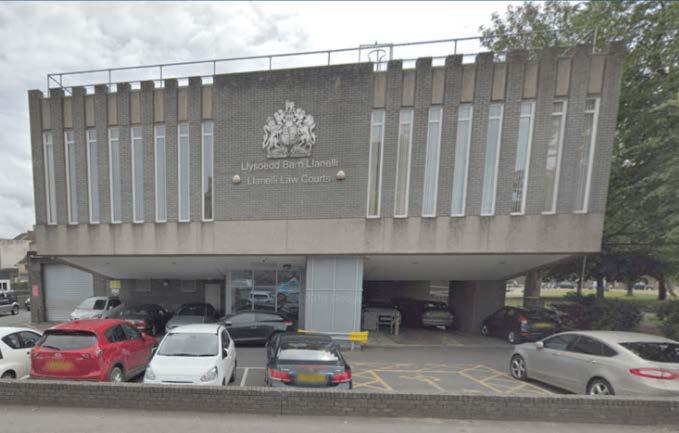

WHat began as an interest in sword collecting resulted in a criminal conviction for Milford resident jake Cane after four offensive weapons – one with a blade measuring 72 centimetres long – were discovered at his property during a police search earlier this month.
The 33-year-old was arrested by officers on October 10 and taken into custody for questioning on an unrelated matter. Whilst in custody, officers carried out a search at his property in Cherry Tree Close, Milford Haven. There they discovered a blue samurai-style sword with a curved blade measuring 72 centimetres in length. Also found was a grey samurai style sword which also had a curved blade measuring 70 centimetres in length, a black ninja sword with a tanto style angled point measuring 35 cm in length and a black ninja sword with a tanto style point measuring 45 cm in length.
This week Cane appeared before Haverfordwest magistrates where he pleaded guilty to four charges of possessing an offensive weapon in a private place.
“He told the officers that the weapons were purely ornamental, but this is not acceptable,” Crown Prosecutor Chris Evans told the magistrates.
“Even though no harm was done by

the defendant, the matter is aggravated by the fact that he had four weapons.”
Cane was represented in court by solicitor Tom Lloyd who stressed that the weapons were purely decorative.
“This is simply someone who has an
A hAVERFORDWEST man has been remanded in custody after admitting a public order offence and denying a charge of criminal damage.
Carl Rago, 29, of Scotchwell View, Haverfordwest, appeared before Llanelli Magistrates’ Court on Monday (Oct 27). He pleaded guilty to using threatening or abusive words or behaviour likely to cause harassment, alarm or distress, contrary to section 5(1) and (6) of the Public Order Act 1986. The offence took place in Haverfordwest on October 22.
Rago also faces a further charge of criminal damage to a white Vauxhall Corsa which was alleged to have taken place on the same day. He is accused
of damaging the vehicle without lawful excuse, contrary to sections 1(1) and 4 of the Criminal Damage Act 1971. Rago entered a plea of not guilty to that charge. Magistrates remanded him in custody after considering the nature and seriousness of the offences, as well as his previous record. The court noted that a bail address was still being verified by police.
Rago will next appear before Haverfordwest Magistrates’ Court via live link on Monday, November 3, at 10:00am. The complainant in the case is entitled to lifelong anonymity under Section 1 of the Sexual Offences (Amendment) Act 1992.

interest in these weapons and began collecting them when it was legal to do so,” he said. “But obviously things have now changed.
“They were purely decorative and something which he put up on his wall.”
After considering the mitigation, magistrates issued a deprivation order for each of the four weapons seized by officers. Cane was fined £480 and ordered to pay a £192 surcharge and £85 costs.

OnE of Wales’ most recognisable thrill rides is leaving Pembrokeshire for good. Oakwood Theme Park’s legendary rollercoaster, Speed: no Limits, is set to begin a new life at Walygator Sud-Ouest in Roquefort, France.
After almost twenty years of dominating the skyline with its dramatic 97-degree drop, the steel coaster — built by German engineering firm Gerstlauer — will soon thrill a new generation of riders across the Channel.
First opened in 2006, Speed: No Limits was the UK’s first Euro-Fighter model, propelling riders down a beyondvertical plunge at close to 60mph. It quickly became the pride of Oakwood and a must-ride for thrill-seekers visiting west Wales.
Confirming the move, Walygator Sud-Ouest’s Director of Marketing, Benoît Baylocq, said: “The former Speed rollercoaster from Oakwood Park will soon be joining our site. As of today, the public opening date for this new attraction has not yet been determined, as construction work has not yet begun. We are currently awaiting administrative authorisations before we can start the project.”
He added: “We will announce the

Tom Sinclair editor@herald.email
official opening date as soon as these steps are completed.”
The park’s Director, Sylvain Chatain, said the new arrival will offer “more thrill than Boomerang”, currently their biggest ride, adding: “It’s time for Walygator to grow up.”
POLICE have installed cameras in the Fort Road car park in Pembroke Dock to crack down on anti-social driving.
The move follows reports of vehicles being driven dangerously and causing a nuisance in the area. Officers say the cameras are intended to act as a
deterrent and help identify offenders.
A spokesperson for Pembroke Dock and Pembroke Police said: “Cameras have been installed in the Fort Road car park to deter vehicles driving in an anti-social manner. Any drivers caught behaving irresponsibly will be dealt with appropriately.”

After thirty years of operation, the 20-hectare French park is undergoing major redevelopment — and the arrival of Oakwood’s famous coaster could be the headline attraction.
For rollercoaster fans, it marks the end of an era for Oakwood, but the start of a new chapter for a Welsh icon set to roar again in France.
nEW figures show shoplifting offences have fallen sharply across the Dyfed-Powys Police area – but retail union usdaw has warned the apparent reduction may mask the true scale of retail crime, with many incidents now going unreported.
According to the latest statistics from the Office for National Statistics, recorded shoplifting fell by 14% in DyfedPowys in the year to June. Across Wales as a whole, there was a 6% drop, while neighbouring forces saw mixed results –South Wales Police down 11%, Gwent up 2%, and North Wales up 3%.
The figures buck the wider England and Wales trend, where shoplifting has more than doubled since the pandemic, rising from 228,250 incidents in 2021 to 529,994 by June 2025.
However, retail staff and unions warn that the apparent improvement in West Wales could reflect under-reporting rather than a real decline.
Usdaw says many shop workers and store managers no longer bother calling police for smaller thefts, citing low response rates and the £200 prosecution threshold, which often means offenders are not charged. Others deal with incidents internally or through store bans rather than formal reports.
Usdaw General Secretary Joanne Thomas said: “It is welcome that there
has been a small decrease in policerecorded shoplifting in Wales, but retail crime remains far too high and has more than doubled since the pandemic. Our survey shows this is not a victimless crime — repeated and persistent thefts can lead to anxiety, fear, and even physical harm for retail workers.
“We’ve campaigned with many retailers for tougher measures, and we’re pleased that the Government’s new Crime and Policing Bill is progressing through Parliament. We now need that legislation to deliver real protection for shop workers, end the indefensible £200 threshold for prosecuting shoplifters, and provide funding for more uniformed police patrols in shopping areas.”
Usdaw’s latest survey of 9,500 retail staff found that 77% had experienced verbal abuse, 53% had been threatened, and 10% had been assaulted in the past year. Two-thirds said those incidents were triggered by shop theft or armed robbery.
The union will release new interim figures from its ongoing research during Respect for Shopworkers Week, which runs from 10–16 November.
Usdaw represents around 360,000 members, mostly in retail, and runs the long-standing Freedom from Fear campaign aimed at tackling violence and abuse against shop staff.
A court has heard how a homeless and alcohol-dependent man stole food and alcohol at a time when he was leading what was described as ‘a chaotic lifestyle’.
Ashley Mardon, 37, was seen entering the Albion Stores in Pembroke Dock on February 11 and remove a pizza dip, a pizza and two Rustler chicken burgers.
The following month he returned to the same store and once again stole food and alcohol – this time a crate of Stella Artois lager and two Micro Meals. The total value of the stolen goods amounted to £29.55.
“These offences took place when the defendant was leading a chaotic lifestyle,”
his solicitor, Jess Hill, told Haverfordwest magistrates after Mardon pleaded guilty to both theft charges earlier this week.
“He was homeless, he had serious alcohol dependency issues and each of the stolen items were for his personal consumption.”
Meanwhile Crown Prosecutor Chris Evans informed magistrates that Mardon has 34 previous convictions, 20 of which are for theft.
Mardon, who now resides at the Silverdale Lodge in Johnston, was fined £80 and ordered to pay £85 prosecution costs and a £32 surcharge. He was also ordered to pay £29.55 compensation to the Albion Stores, Pembroke Dock.


A SOuTh WALES man accused of strangling a woman and assaulting a child has now pleaded guilty to two counts of battery.
Alan Hall, 48, of South Road, Sully, previously appeared at Haverfordwest Magistrates’ Court charged with intentionally strangling a woman and assaulting a 14-year-old child during an incident in Solva on 27 August 2023. He had denied those allegations when the case was first sent to Swansea Crown Court earlier this year. However, in a hearing on Monday (Oct 28) he admitted
A 60-year-old motorist has been sentenced by the courts after making the foolish decision to drive to her local Chinese takeaway after downing ‘a couple of glasses of wine’.
Police received calls from members of the public that Catherine Mary Davies, 60, had been seen driving her Audi A3 through Monkton on October 12.
“Police received reports that she was driving after consuming alcohol,” Crown Prosecutor Chris Evans told Haverfordwest magistrates this week.
“She drove past a stationary police car and the officer identified her vehicle,”
Davies was stopped and provided a positive roadside breath test. Further tests carried out at the police station showed she had 45 mcg of alcohol in her system; the legal limit is 35.
Davies, of St Martins Road, Monkton, pleaded guilty to drink-driving and was represented in court by solicitor Tom Lloyd. He informed magistrates that at the time of the offence, Davies was dealing with a number of personal issues which triggered her increased alcohol consumption.
“This is an upstanding member of the community who is currently dealing with
considerable personal and family issues,” he said. “As a result, she has been struggling with her alcohol dependence..”
Mr Lloyd said that Davies is now receiving support from the Dyfed Drugs and Alcohol Service to combat her alcohol intake.
“She’s mortified at being in court today,” he concluded.
“On the night in question, she’d been staying with her mother, she’d had a couple of glasses of wine, she’d had nothing to eat, but then popped out to get a Chinese. That’s when she was stopped by the police.”
Davies was fined £400 and ordered to pay a £160 court surcharge and £85 costs. She was disqualified from driving for 12 months.

two lesser charges of battery.
The offences relate to the same incident in which police were called to reports of a domestic disturbance. The victims cannot be named for legal reasons.
Hall was granted bail while presentence reports are prepared and is due to return to Swansea Crown Court for sentencing on December 1.
The Herald understands the victims have been informed of his guilty pleas and will have the opportunity to submit impact statements ahead of sentencing.


DyFED-POWyS Police has pledged its support for a new Welsh Athletics campaign aimed at making running safer for women during the winter months.
The Own The Night / Ein Nos Ni campaign recognises the growing concerns women have about personal safety when running after dark and encourages both practical action and cultural change across Wales.
The campaign aims to:
• Raise awareness of women’s safety concerns when running at night or in the early morning.
• Empower women to continue running through the winter months with confidence.
• Educate running communities and the wider public on allyship and practical ways to support women.
• Reclaim the streets’ by encouraging clubs and groups across Wales to host a group run on Sunday, October 26, the day the clocks go back.
Hannah Baulch, Head of Participation at Welsh Athletics, said: “Running in Wales is experiencing fantastic growth at the moment, with 293,000 adults participating regularly through organised and informal activity. We’re delighted that since 2020, female runners have made up more than half of our membership — something that’s rare in other sports.
“However, we know that female runners face challenges during the winter months. It’s not just about cold weather or slippery roads — it’s about safety. Research by This Girl Can shows that almost threequarters of women in the UK change their outdoor activity routines during winter, and a recent Our Streets Now survey revealed that 93% of women have experienced public sexual harassment while running. This simply isn’t acceptable.
“We’ve asked Welsh Government for a commitment to make our streets safer, but we also want communities across Wales to support one another by being the light for other runners, showing respect, and calling out bad behaviour. Together, we can make a real difference.”
Dyfed-Powys Police is backing the campaign by sending Neighbourhood Policing and Prevention Teams to local running clubs and events to hear directly from runners about their experiences.
Detective Superintendent Wayne Bevan, the force’s lead for protecting vulnerable people, said:
“Women should not feel that they have to change their running habits during the winter months, but sadly many do. Everyone deserves to be safe, and to feel safe. It’s not right that women feel fearful to run their usual routes once the darker evenings set in.
“We’re pleased to support this campaign by Welsh Athletics and hope it will empower women to keep running throughout the winter. We’ll be visiting local clubs, Parkruns and running events to speak to runners and listen to their concerns.
“Anyone who experiences harassment or intimidating behaviour while running should report it to the police so we can investigate. If you feel unsafe due to environmental issues such as poor lighting, please report it via the StreetSafe website.” StreetSafe allows people to report safety concerns like poorly lit streets or vandalism, although it is not for reporting crimes.

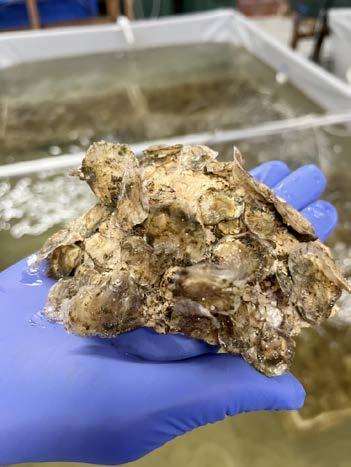
A MAjOR environmental milestone has been reached in Pembrokeshire as 50,000 native oysters were deployed into the Daugleddau Estuary, forming the foundations of new living reefs that will filter coastal waters, store carbon, and provide shelter for marine life.
The work, carried out this month by the Marine Conservation Society, is part of Natur Am Byth! — Wales’s largest natural heritage and outreach programme. The initiative is led by a coalition of nine environmental charities
with Natural Resources Wales, and supported by the National Lottery Heritage Fund and Welsh Government.
The oysters came from Câr-yMôr, the community-run seaweed and shellfish farm near St Davids, and were carefully placed within the protected estuary. The aim is to rebuild onceabundant native oyster reefs that were wiped out by overfishing and pollution in the last century.
Bridget Orchard, Wales Programme Manager at the Marine Conservation Society, said: “This is a major milestone in our efforts to restore native oysters to Welsh waters. These adult oysters are more than just a species reintroduction — they’re foundational to marine ecosystem health, and their return signals the beginning of a wider recovery.”
Alongside the deployment, another 50,000 baby oysters have been moved from Bangor University — where they were reared with help from the Pembrokeshire Coast National Park Authority — to Tethys Oysters in Angle Bay. There they will continue to grow until 2027, when they too will be restored to the seabed.
This next phase is funded by clothing company FatFace and the FatFace Foundation, who are supporting the ongoing care of the juvenile oysters.
Carly Jones, Senior Brand Marketing Manager at FatFace, said: “Supporting

the restoration of native oyster reefs in Wales reflects our commitment to protect and restore the environments that sustain us. We’re proud to help enable this vital work with the Marine Conservation Society.”
The project is part of the Marine Conservation Society’s new Atlantic Coast Programme, which will build on restoration work already underway in Wales. The scheme aims to expand
restoration of oysters, seagrass and kelp along the UK’s western coastline — helping to tackle climate change, improve water quality, and rebuild lost marine habitats.
The work has also involved Sue Burton, SAC Officer for the Pembrokeshire Marine Special Area of Conservation, the Pembrokeshire Coast National Park Authority, and Bangor University’s School of Ocean Sciences.

A MOVEMEnT that began in Pembrokeshire has grown into a uk-wide campaign urging the uk Government to allow communities to open their homes to Palestinians displaced by the war in Gaza.
The group, Communities for Palestinians UK, says hundreds of people across Britain have come forward to express interest in welcoming families under the UK’s community sponsorship model — a scheme that enables local groups to support refugees resettled through the UNHCR.
However, the current scheme does not extend to people fleeing Gaza.
The campaign was started by experienced community sponsor groups, alongside grassroots organisations and individuals with friends and family in Gaza. It has already received more than 650 responses from people wishing to help. One of the organisers, Vicky Moller from Pembrokeshire, said: “It has been an adventure of love, laughter and learning. Our rural market town shone with pride in its hospitality. All we ask is permission to bring our friends here, to start their healing

journey, bringing their courage, courtesy and talents.”
The group argues that allowing communities to nominate and support families directly would help address public concerns around migration, while offering a humane route to safety.
A founder of the coalition said the model offers “integration through trust,” adding: “The families we want to host will come to the communities ready to integrate — with security, work, friends and neighbours. In Wales that means children learn both Welsh and English in their first year.”
Personal testimonies from Gaza paint
a grim picture of the ongoing humanitarian crisis, despite the temporary ceasefire.
A 19-year-old woman told the group: “I’ve been waiting for two years. These are the days of my youth, and I must seize them, learn, and help my family.”
Another young father said: “I was displaced more than 18 times due to evacuation orders. I dream of reaching the UK. The war shattered everything.”
The UK Government has said it continues to provide humanitarian aid in the region, but has not announced any plans to expand community sponsorship to Palestinians.

A TEn-yEAR-OLD boy has cycled across Pembrokeshire to raise vital funds for the RnLI, visiting lifeboat stations at Tenby, St Davids and Fishguard along the way.
On Saturday (Oct 18) Fishguard RNLI crew welcomed back a special guest to mark the end of a remarkable 66-mile (100km) charity ride.
Henry Warwick, from Herefordshire, set off from Tenby just after 8:00am and completed his journey nine hours and ten minutes later, arriving at Fishguard to a warm welcome from volunteers, family and friends.
Henry was inspired to raise funds for the lifeboat charity after visiting Fishguard RNLI in February, where he met full-time Coxswain Gemma Gill. During the visit, he was surprised to learn that the RNLI receives no government funding and relies entirely on public donations.
Following the visit, Henry began planning his challenge with an initial target of £500. However, after visiting Tenby lifeboat station and seeing a display showing the cost of personal protective equipment (PPE) — totalling £3,241 to fully kit out one crew member — he set his sights higher. By the time he started the ride, he had already reached that ambitious goal, and his fundraising total now stands at £3,708.
Henry said his training was nearly derailed after an accident just weeks
Tom Sinclair editor@herald.email
before the ride.
“I fell off my mountain bike in September and badly hurt my knee,” he said. “I had five stitches across my kneecap and had to postpone the ride. I lost a lot of training time, but I was determined to finish what I’d started.”
Joined by his father Hugh, Henry cycled across the county, completing the final stretch from Trefin to Fishguard alongside RNLI volunteer Ian Davies. Crew member Cedwyn Rogers met them near Goodwick in a vehicle decorated with RNLI banners, leading the pair into the station where they were greeted with cheers and home-baked cakes.
Henry said: “It felt really welcoming to have everyone clapping for me as I arrived. I was so glad to finish and really proud of what I’d achieved.”
Fishguard RNLI Volunteer Lifeboat Press Officer Cedwyn Rogers said: “From all of us at Fishguard RNLI, we want to say a huge well done and thank you to Henry and his family. It was a big undertaking and the weather made it even tougher. It’s amazing to think this all came from a brief conversation with Gemma during a visit — it really shows how one moment can inspire someone to do something extraordinary to help us continue our lifesaving work.”


ThE LAunCh of the 2025/26 Royal British Legion Poppy Appeal took place on Castle Square, haverfordwest, on Saturday (Oct 25).
County councillor for the Castle Ward, Thomas Tudor, who is also a member of the Royal British Legion (Haverfordwest Branch), said it was an honour to be invited by branch secretary Graham Johnson to attend the ceremony.
Representatives from The VC Gallery and Haverfordwest Town Council joined members of the public to mark the start of this year’s fundraising campaign, which supports veterans and their families.
Cllr Tudor was joined at the event by Donna Rose Evans and Tamitha Grey.
The service closed with the traditional words of remembrance:
“They shall grow not old, as we that are left grow old:
Age shall not weary them, nor the years condemn.
At the going down of the sun and in the morning
We will remember them.”
Brave veterans and guests marked the occasion with a moment of reflection.

A CO n CER n ED walker has raised the alarm after finding an injured seal trapped among rocks at Presipe Beach near Manorbier.
Local resident Gary Nevinson said he discovered the seal wedged between boulders and managed to drag it to safety on the sand — but soon realised the animal appeared unable to use its front flippers.
“I phoned the marine group who said it looks fine and wouldn’t intervene,” he said. “How they can say that from a photo is beyond me. The next high tide will bounce it around the boulders again.”
The incident, which occurred on Sunday (Oct 26), has prompted calls for a review of how wildlife distress calls are assessed remotely.
Presipe’s remote location and steep access make it difficult for rescuers to reach quickly, particularly during rough weather or changing tides.
Wildlife volunteers have been urged to keep an eye on the animal if it remains in the area.
The Herald understands that this follows another recent case in Pembrokeshire where a mutilated seal pup was found near Moylgrove earlier this month — raising wider concerns about the pressures facing the county’s seal population during the pupping season
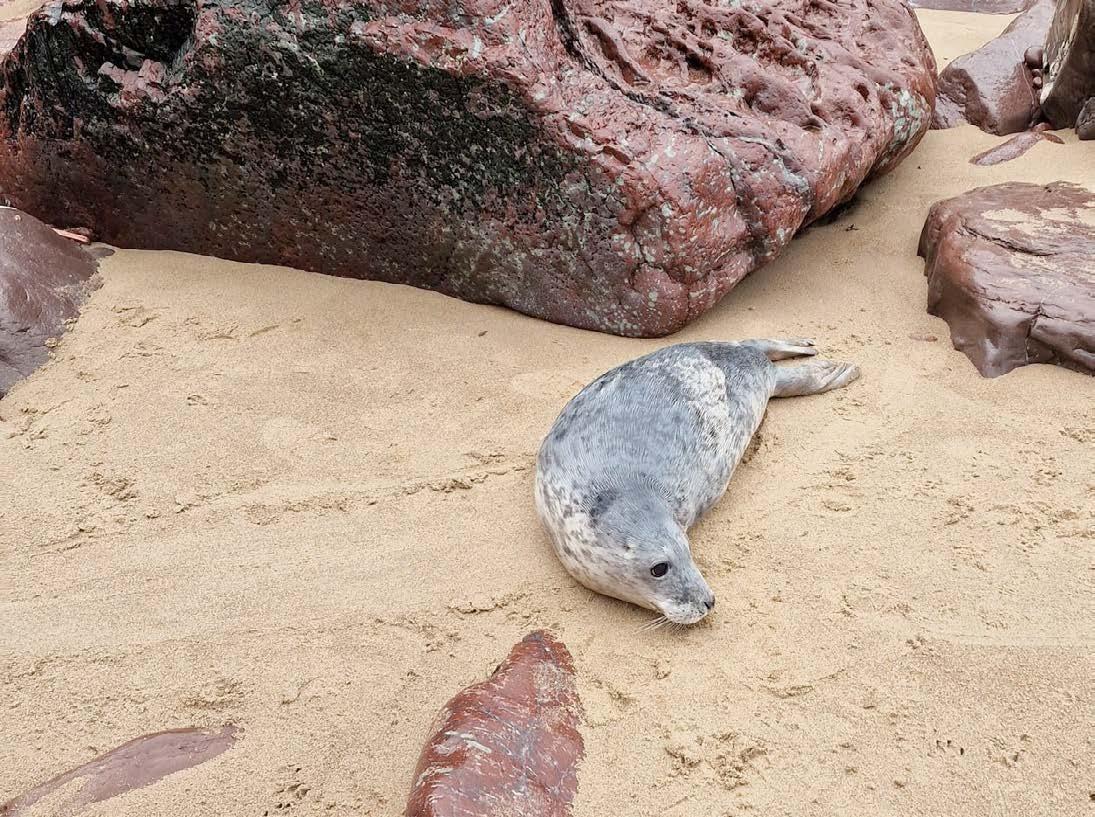
TEnBy TOWn COunCIL is inviting applications from local residents to fill two vacancies — one in the South Ward and one in the north Ward — following no election being requested. The vacancies will now be filled through co-option.
Serving as a town councillor offers the opportunity to make a real difference to the quality of life in your community. Councillors play a vital role in representing local views, helping to shape services, managing public funds, and ensuring the best value for residents.
You do not need to belong to a political party to apply. The council welcomes individuals who are passionate about Tenby, engaged with community issues, and committed to working for the benefit of local people.
Anyone wishing to be considered for co-option should submit a letter outlining their reasons for applying and the qualities they can bring to the council.
Letters should be sent to:
Sharon Thompson, Deputy Clerk, Tenby Town Council, De Valence Pavilion, Upper Frog Street, Tenby SA70 7JD
or emailed to tenbytownclerk@ btconnect.com by Friday, November 7, 2025.
Applicants must be:
Aged 18 or over.
• A British citizen, Commonwealth citizen, citizen of the Republic of Ireland, a relevant citizen of the European Union, or a qualifying foreign citizen.
• Registered as a local government elector for the community, or
• Have occupied land or premises in the community for the past twelve months, or
• Have had their principal or only place of work in the community during the past twelve months, or
• Have resided in the community or within three miles of it during the past twelve months.
Applicants must also not be disqualified under Section 80A of the Local Government Act 1972 or any decision made under Section 79 of the Local Government Act 2000.

CAMROSE Vintage Working Day celebrated its 38th annual Presentation night with a recordbreaking total of £33,000 donated to local causes.
A total of £32,000 was shared among 32 charities, with an additional £1,000 allocated for a replacement defibrillator at Pelcomb Cross. The event’s total donations over its 38year history have now reached almost £300,000, all benefiting Pembrokeshire organisations and community groups.
COMMunITy
Chairman Andrew James opened the evening by thanking volunteers, exhibitors, trade stands, sponsors and the local community for their support, calling this year’s show “the biggest ever.”
Guests heard from representatives of several charities about the difference the donations make to their work, with many explaining how such contributions allow them to continue delivering essential services to local people.
There was also a heartfelt farewell from Shalom House, which is closing after years of providing palliative care, thanking the Camrose Vintage Working Day committee for its longstanding support.

ChARITIES SuPPORTED ThIS year
Among the many beneficiaries were: Adam’s Bucketful of Hope, Blood Bikes Wales, Brain Research UK, Brain Tumour Research, Camrose and Roch Playgroup, Cariad Pet Therapy, Cardiac Risk
in the Young, Cystic Fibrosis Trust, The DPJ Foundation, Greenacres Rescue, Hope MS Therapy Centre, Paul Sartori Foundation, Wales Air Ambulance, and several others.
Photos were taken of Chairman Andrew James with the presentation cheque and representatives from the charities, followed by a buffet supper prepared by members of the
organising committee.
LOOkInG AhEAD TO nExT yEAR
The committee expressed its thanks to everyone who helped make the 2025 event such a success and confirmed that the 39th Camrose Vintage Working Day will take place on Saturday, August 29, 2026.
25 years with the return of the Antiques and Vintage Fair at the Garedens.

tHe national Botanic Garden of Wales celebrates 25 years with its popular Antiques Fair and Vintage Market.
Exciting news that the much loved National Botanic Garden of Wales Antiques Fair and Vintage market is returning to the Gardens Sa328HN on Saturday 8 th and Sunday 9 th November with the same quality stands .This will be marking 25 years since the impressive Garden opened to the public in that historic Millennium year2000. The Garden has under gone a huge transformation in those 25 years and has matured into a wonderful venue for the Antiques Fair.
Nestling into the Carmarthenshire countryside ,on the outskirts of Carmarthen and just 15 minutes away from the end of the M4, it’s conveniently situated.
The weekend of antiques, is set to be a busy one .The success of the fair has been mainly down to the diversity and quality of the antiques on display in the splendid setting of the Garden. Fans of classic antiques should make their way to the various Garden venues – including the Great Glasshousefor displays of Welsh art and pottery, quality jewellery and outstanding militaria collections.Step next door to Principality House which is now known as Ty Melyn and discover displays of quality Welsh textiles,a superb array of books, jewellery , silver and Welsh samplers plus artwork and vintage delights.

Matthew’s Churchat Millbrook in Jersey (Lalique’s “Glass Church”).As part of the Art Nouveau style, many of his jewellery pieces and vases showcase plants, flowers and flowing lines.
In 1907, Lalique began collaborating with François Coty to design luxury perfume bottles.He eventually created hundreds of different models, many of which became iconic, for companies such as Guerlain, Houbigant, Worth, Rogeret et Gallet, D’Orsay, Forvil, and Worth.
The recently transformed Theatr Botanica will be exhibiting old favourites such as silverware and collection of Moorcroft, Lorna Bailey, Beswick and Doulton , art and treen plus collections of quality welsh furniture and textiles and treen and quality jewellery.There will be folk art, stick chairs and French brocante. The Gallery room is also a welcome addition and will be show casing Welsh furniture and textiles and French brocante and some beautifully curated stands. The Apothecary will also be used as a go to venue for some more vintage and militaria.
Millennium Courtyard will be filled with a Vintage market , housing smaller marquees displaying vintage toys,clothing, retro and upcycled furniture .
There will be a good representation of art glass which has proved to be very popular at the fairs. There will be some classic pieces including pieces by Rene Lalique
Rene Lalique and his art deco glassware is unequivocally the most instantly recognisable makes of glassware within decorative arts and glass making . Lalique must be regarded as one of the foremost exponents of art nouveau glass and it’s not unreasonable to think of him as one who did more than any other, to elevate the humble trade to a level where it could rightly be regarded as an art form in its own right. Lalique’s early life was spent learning the methods of design and art he would use in his later life. At the age of two, his
family moved to the suburbs of Paris, but traveled to Aÿ for summer holidays. These trips influenced Lalique later on in his naturalisticglasswork. With the death of his father, Lalique began working as an apprentice . In 1876, at 16, René Lalique was apprenticed to the jeweler Louis Aucoc. Aucoc was among the leading jewelers working in Paris at the time, and this provided the young René Lalique with an excellent opportunity to learn jewelry production and design. During this time, Lalique also studied at the Ecole des Arts Decoratifs in Paris. By 1881, Lalique worked as a freelance designer for several French jewelry firms, including Cartier and Boucheron. In 1886, he started working in his workshop in Paris, in the former workshop of Jules Destape. In 1890, René Lalique opened a jewelry store in the Opéra district of Paris. While working in this new shop, some of René Lalique’s most famous jewelry designs were created, as well as his experimentation and use of glass. The main motif of Lalique’s jewelry design was the natural world. His designs often featured motifs such as dragonflies, orchids, and peacocks, crafted using a combination of enamel, gemstones, and semi-precious materials.Lalique surrounded himself at work with flowers to serve as subtle inspiration for his art. These motifs symbolized the organic flow of life, metamorphosis, and beauty in motion. He was influenced not only by the nature of the French countryside but also by the motifs of Japanese nature art. And he incorporated many materials into his jewellery that were not widely used in high-end jewellery in his time, including glass, horn, pearl, semi-precious stones, enamel, and ivory. He used typical period gemstones only for artistic appearance and not for their value. Therefore, his Lalique jewelry creations were not just holders of precious stones, they were works of art in their own right, creating worldwide interest and great demand Lalique was best known for his creations in glass art. In the 1920s, he became noted for his work in the Art Deco style. He was responsible for the walls of lighted glass and elegant coloured glass columns which filled the dining room and “grand salon” of the SS Normandie and the interior fittings, cross, screens, reredosand font of St.
Lalique was also a pioneer in the use of ‘pâte-de-verre,’ an ancient glassworking technique, which he used to mold ground glass into intricate, lifelike forms in both jewelry and decorative objects.
Both unique and commercial works of René Lalique are in the collections of a large number of public museums around the world including the Museu Calouste Gulbenkian in Lisbon, the Lalique Museum of Hakone in Japan, the Musée Lalique and the Musée des Arts Décoratifs in France, the Schmuckmuseum Pforzheim [de] in Germany, the Victoria and Albert Museum in London, the Metropolitan Museum and the Corning Museum in New York State, and the Rijksmuseum in Amsterdam
The fair also has had a reputation for showcasing Welsh areas of collecting including Welsh pottery, welsh blankets,Welsh art and furniture. Again not to disappoint , there will be an amazing display of period Welsh oak furniture . From Welsh child’s chairs,milking stools to much larger pieces including dressers and linen press cupboards.Richard Bebb’s collection of Welsh artists is impressive and a stand not to be missed.
The fair also has a rich cross section of antiques and vintage on display, from jewellery,watches, books and silver , including ephemera, militaria and vintage clothes and accessories. There will also be collections of art glass and up cycled and pre loved furniture, plus interior design pieces including French brocante. I’m sure visitors will not be disappointed with the selection on offer at this popular fair.
ThE FAIR OPEnS AT 10AM AnD CLOSES AT 4.00PM
Admission is £12 for a weekend ticket allowing you to enjoy 2 full days at the Antiques fair , plus a further 5 days admission to the Garden. The tickets last for 7 days which is very good value.Dogs are now welcome over the Antiques weekend except in the Glass House.
For more information contact Derwen Fairs 07790293367 or follow on FB,Twitter and Instagram




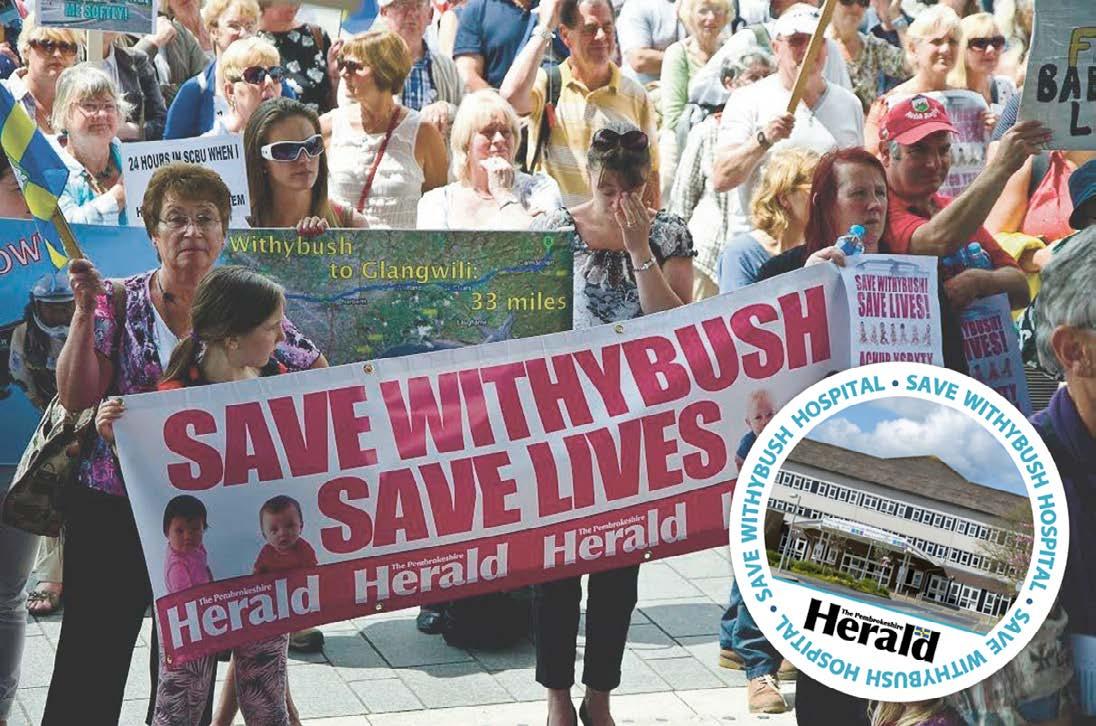
On a grey july morning in 2013, a small team of reporters gathered a makeshift office Milford haven’s hamilton Terrace. The air smelled of ink, takeaway coffee, and fresh ambition. Outside, the docks shimmered with summer drizzle; tankers groaned in the estuary, a reminder that Pembrokeshire’s fortunes were often tethered to industries bigger than itself.
Inside, though, another tide was turning. That morning, the first edition of The Pembrokeshire Herald rolled
off the presses and onto newsstands across the county.
It was a gamble few thought wise. Regional journalism across the UK was collapsing. Newsrooms were closing at a rate of one a week. Advertising revenues had dried up, circulation was plummeting, and Wales was hit especially hard. Even the venerable Western Telegraph, with its 150-year pedigree and corporate backing, looked nervous.
And yet, the Herald sold out. Locals queued at corner shops and petrol stations to grab a copy. For £1, readers were promised something

rare: a paper that would be theirs— unafraid, unfiltered, and unpolished. welve years on, as the Herald breaks digital records with more than 14 million views in a single month, its story is one of survival, reinvention, and disruption. From council scandals to choir fundraisers, it has not only chronicled Pembrokeshire—it has changed how the county sees itself.
The Herald’s beginnings were almost cinematic.
“Everyone thought we were mad,” recalls founding editor Thomas Sinclair, still at the helm today. “Papers were dying all around us, and here we were launching another one. But we believed Pembrokeshire deserved something better—something that didn’t just recycle press releases.”
The first issue carried stories that cut against the grain: a scathing piece on county hall overspending, a photoled feature on lifeboat volunteers, and letters from readers who felt ignored by the established media.
The ethos was simple: be the people’s paper. If a farmer in Crymych was angry about planning rules, or a pub landlord in Tenby had a gripe about business rates, they would find their voices printed alongside reports of Senedd debates and crime in Haverfordwest.
Within weeks, the Herald was shifting around 10,000 copies a week. For a county of just over 120,000 people, that was remarkable. Its early success rattled the Western Telegraph, which had long enjoyed unchallenged dominance.
By 2014, emboldened by sales, the Herald launched sister titles in Carmarthenshire and Ceredigion, signalling it wasn’t content with being a local irritant—it wanted to redefine journalism across West Wales.
The mid-2010s were the Herald’s golden years. Circulation climbed, digital traffic surged, and the paper became a lightning rod for controversy.
One of the fiercest battles came in 2016, when the Herald’s bold marketing—claiming it had overtaken the Western Telegraph in reach—


provoked a furious response. The Telegraph’s parent company complained to the Advertising Standards Authority (ASA), demanding the Herald prove its numbers.
Twice the ASA dismissed the complaints. “It was classic David versus Goliath,” Sinclair remembers. “They couldn’t stand that we were growing.”
The feud only raised the Herald’s profile. It doubled down on innovation: live-streaming council meetings, experimenting with podcasts, and even testing a radio station. Readers flocked to its coverage of issues like youth unemployment, mental health crises, and planning rows that reverberated from village halls to the Senedd floor.
BuT COnTROVERSy WAS nEVER FAR AWAy.
In 2013, an obscene advert accidentally slipped into print, sparking outrage—and free publicity.
In 2017, Sinclair himself was fined for breaching reporting restrictions in a sensitive case. Critics crowed, but supporters saw it as proof of a paper pushing boundaries.
“The Herald was messy,

sometimes chaotic,” says one former reporter. “But it was alive in a way local journalism hadn’t been in years.”
ThE ABySS
In October 2019, the wave almost broke.
The Herald’s parent company collapsed under the weight of spiralling print costs and a botched investment, shuttering three titles and threatening 24 jobs. “It was devastating,” Sinclair admits. “We’d built something people believed in, and suddenly it was gone.”
Forums filled with laments.
One commenter wrote: “Without




the Herald, who’s going to ask the awkward questions?”
For Pembrokeshire—where 26% of residents are over 65 and rural isolation makes local news more than a luxury—the loss felt existential.
Salvation came unexpectedly. A Spanish print and media firm, Richographic España, swooped in with emergency funding. The Herald returned, leaner and chastened, but alive.
The scare revealed a hard truth: independent journalism is fragile. Without it, who holds local power to account?
The near-death experience forced reinvention.
By 2023, with print costs unsustainable, the Herald made a radical move: it scrapped print altogether, pivoting to a free weekly 128-page digital edition.
The gamble paid off. The first e-edition was downloaded more than 100,000 times. With clickable ads, instant shares, and no paywalls, it reached corners of the county that had never picked up a paper copy.
Traffic exploded. Facebook followers climbed past 51,000
(overtaking the Western Telegraph’s 47,000), monthly web uniques hit half a million, and social engagement dwarfed that of rivals.
The Herald’s new strength was speed. While the Telegraph often waited to polish features, the Herald broke stories first:
• Avian flu detected near Roch.
• Military flyovers during Russian naval manoeuvres off the coast.
• RAAC concrete crises threatening local schools.
On X (formerly Twitter), users hailed it as the go-to for “what’s actually happening.”
RIVALRy REkInDLED




For more than a century, the Western Telegraph had been unchallenged. But the herald’s swagger forced it to adapt.
That 2016 ASA spat was only the tip of the iceberg. The real battle was for hearts and eyeballs.
The Herald won them with raw immediacy. Viral stories of goats invading a churchyard or choirs raising money for cancer care travelled faster than any polished Telegraph feature.
Locals noticed. “The Herald feels like us—raw and real,” tweeted one user after coverage of council budget cuts.
Competition sharpened the entire ecosystem. With two strong voices jostling, Pembrokeshire readers got more scrutiny, more coverage, and more choice.
If the Herald earned its reputation by ruffling feathers, it cemented its value by lifting spirits. Alongside exposes and political spats, the paper has consistently championed Pembrokeshire’s brighter side.
When the Ty Newydd pub in Dinas Cross faced closure in 2023, Herald coverage helped galvanise more than 200 locals into raising the cash to save it. “Inspiring local journalism at its best,” one X user wrote as the victory went viral.
Schools, too, have felt the Herald’s boost. Milford Haven School’s Gold Calon Y Gymuned award for family engagement in July 2023 was splashed across its pages, with headteacher Sara Davies crediting the coverage for “putting community success on the map.” A year later, the Herald’s GCSE features turned dry exam stats into proud family moments, with parents flooding its comments section to thank it for spotlighting their children. The paper’s business coverage often
becomes a loop of positivity. In 2024, when hardware stalwarts W.B. Griffiths & Son scooped a £2,000 Pembs Lottery prize, they pledged it to local projects — citing the Herald’s years of community coverage as a key motivator. “It keeps us connected,” the owners said.
And when Pembrokeshire County Council secured the insport Gold Standard for inclusive sport, Disability Sport Wales hailed it as a “remarkable milestone” — and locals praised the Herald for making it front-page news. These moments reveal something the numbers alone can’t: that the Herald is more than a scrappy watchdog. It’s also a mirror of community pride, amplifying joy as fiercely as it scrutinises power.
Perhaps the most surprising twist in the Herald’s evolution has come since its digital relaunch: the paper is no longer just Pembrokeshire’s chronicler. Increasingly, it is a bridge between the local and the global.
Take the Jaguar Land Rover cyberattack in September 2025. The story was everywhere—production halted at JLR’s UK plants, suppliers fearing collapse, the UK government stepping in with a £1.5 billion loan. National headlines framed it as a crisis for British industry.
The Herald’s version? A piece titled “JLR cyber-attack sparks fears for Welsh supply chain”. Within hours of the news breaking, Sinclair had tied the story to ZF Automotive in Pontypool, a Welsh supplier employing dozens and recently backed by Welsh Government cash. The message was clear: what happens in Solihull or Delhi could hit Wales next.
A few days earlier, the Herald had run multiple articles on the Charlie Kirk shooting in the US. Where national media focused on America’s gun politics, the Herald made it resonate

in Wales: local MSs Samuel Kurtz and Darren Millar linked the killing to free speech debates in Welsh universities, even pushing for a Senedd tribute.
tH is is t H e ne W Hera L d PLAyBOOk: START GLOBAL, EnD LOCAL
• Bank closures in Haverfordwest become part of Chinese state media coverage on UK economic decline.
• Ukraine aid debates turn into stories
about how sanctions hit Welsh farmers.
• US tariffs get framed through Pembrokeshire exporters.
It’s not dilution. It’s amplification. In an era when readers can access global news with a swipe, the Herald’s edge is showing why it matters here—in Fishguard, in Tenby, in Milford Haven.
e c H oes in t H e community


Beyond clicks and rivalries, the Herald’s impact is measured in voices amplified and lives touched.
It campaigned against the digital divide for Welsh speakers.
It investigated care home standards and planning controversies that spurred petitions.
It exposed scams targeting pensioners, warning thousands before more damage was done.
In a county where business survival rates are half the Welsh average, its coverage of grants, investments, and community projects kept people informed about lifelines.
“Without the Herald, I’d never have known about the funding that helped me save my shop,” says a Tenby café owner.
And when Pembrokeshire’s small producers — from vineyards to leatherworkers — took their products to Westminster, the Herald was there to capture it. MP Henry Tufnell later remarked that its stories “drive innovation and prosperity,” showing the paper’s role in amplifying the rural economy.
Even social media tells the tale. The Pembrokeshire Vikings rugby team thanked the Herald for sponsoring a player’s birthday celebration. The Welsh Organic Tannery posted “Diolch” for Herald photos of their Christmas Fair
success. And PR agencies regularly highlight Herald stories as proof of local buzz. In an age of fleeting feeds, those simple thank-yous show a deeper truth: the community sees the Herald not just as a newspaper, but as a neighbour.
Lessons and t H e road a H ead
Twelve years on, the Herald stands as proof that local news can adapt. From its scrappy print launch to its free digital empire, it has shown survival is possible—even in the harshest climate.
• Can the free model sustain itself long-term?
• Will more partnerships with the BBC or AI-driven alerts keep it ahead?
• Could its blueprint be copied in other rural counties starved of news?
For now, Sinclair is reflective but resolute. “We’ve shown local news isn’t dying—it’s adapting. From print rebels to digital warriors, we’ve kept Pembrokeshire’s pulse beating.”
The Irish Sea still pounds Pembrokeshire’s cliffs. Sheep still outnumber people. But thanks to one rogue wave of a newspaper, the county’s stories are louder, sharper, and freer than ever.




PEOPLE across Wales are being urged to have their say on how the nation’s health and social care services should look in the future.
LLAIS, the independent body set up to make sure people’s views are heard, is hosting The Health and Social Care We Want – a national conversation on creating fairer and more person-centred services.
SO far, more than two thousand people have taken part through events, surveys and group discussions. With the conversation closing on November 1, Llais is calling for more responses from rural communities, people with sensory loss or long-term conditions, children and young people, and ethnic-minority groups.
ONE of the organisations that has worked with Llais is The Gap Wales, a charity supporting asylum seekers, refugees, the homeless and vulnerably housed.
Byron James, Operations Manager at The Gap Wales said: “At The Gap Wales, we work alongside people who often go unseen and unheard, not just in national conversations, but in their everyday lives. Their voices are often
Tom Sinclair editor@herald.email
missing from the decisions that shape their futures.
“Being part of this project gave them a rare opportunity to share their stories and gain insight into the systems that affect them. That sense of visibility and inclusion is powerful, and it helps build confidence.
“This kind of participation is essential if we want to create a system that truly reflects people’s needs and priorities. We’d encourage others to take part in this conversation.”
LLAIS Chief Executive Alyson Thomas added: “With the national conversation closing soon, we urge everyone to take part. Your voice can help shape a better system for everyone.”
THE conversation runs until November 1, 2025, after which Llais will publish a report outlining key findings, recommendations and a framework for change.
PEOPLE can take part by completing the online survey or attending an event. More details are available at llaiswales. org/wewant.
FAMILIES in Milford haven are invited to enjoy a full day of spooky fun and community spirit as the Milford haven Business Circle presents its halloween Mayhem Day — a free entry event at the Pill Social Centre on Saturday, november 1, running from 11:00am to 11:00pm.
The event promises a packed programme of entertainment for all ages, including a pumpkin competition, best costume contest, and a day-long party featuring music, games and dancing. Local families are encouraged to get creative, join in the competitions, and enjoy a relaxed, friendly atmosphere.
Throughout the day, visitors can enjoy snacks, sweet treats, soft drinks and hot drinks, while the bar opens from 6:00pm for those looking to make an evening of it. Organisers say the
event aims to bring people together and celebrate Halloween in true community style — with laughter, creativity and connection at its heart.
Secretary of the Milford Haven Business Circle, Jaimie Gurney, said: “We’d love to see as many families as possible coming along to enjoy the day. It’s completely free and there’ll be something for everyone – whether you’re entering a competition, dressing up, or just coming to soak up the atmosphere.”
Anyone interested in running a stall at the event can contact secretary. mhbc24@gmail.com for more information.
Halloween Mayhem Day — Saturday, November 1, 11:00am–11:00pm, Pill Social Centre, Milford Haven. Free entry for all!


WALES’ youngest climate champions have taken centre stage in shaping the nation’s environmental future, after the Welsh Government turned Bluestone national Park Resort into a “living classroom” ahead of Wales Climate Week.
Year 5 and 6 pupils from Ysgol Bro Penfro, Ysgol Casblaidd and Ysgol Caer Elen rolled up their sleeves for a day of planting, recycling and learning how to live more sustainably. The workshops encouraged pupils to share ideas and pledges which will feed directly into the Welsh Government’s future climate
The sessions – run in partnership with Bluestone, Size of Wales, Food Sense Wales, Castell Howell Foods, Green Up Farm and NFU Cymru – gave children a chance to explore where food comes from, how it’s produced, and what changes can reduce carbon footprints. Pupils planted micro herbs, designed sustainable school dinners, and created colourful posters promoting
local food.
Rebecca, aged ten, from Ysgol Caer Elen said:
“Today I’ve learned where our food really comes from and how far it travels to get to Wales. It’s made me realise how important it is to eat local food and support the farmers who grow it. My favourite part was planning a meal for our school and trying new vegetables –it’s made me like them a lot more!”
Politicians and pupils join forces
Deputy First Minister and Climate Change Secretary Huw Irranca-Davies joined the pupils in the workshops. He said: “Seeing pupils get hands-on and excited about climate action was inspiring. Their voices will help inform future policies and programmes to support communities, nature and our economy.
“And this event is just the start –we want to hear more from our young people, and from communities across Wales, on the issues that impact them most.”
Bluestone, which hosted the event, is the UK’s first holiday park to be completely fossil-fuel free on purchased
energy. The resort runs on solar power, BioLPG made from food waste, and a fleet of electric vehicles.
Marten Lewis, Bluestone’s Director of Sustainability, said: “At Bluestone we’ve built a regenerative tourism blueprint and work hard to reduce waste in all areas of the business. Teaching pupils to make low-carbon choices gives them practical skills and a deeper understanding of the lifecycle of their food. It’s exactly this kind of communityled change that will help Wales build a sustainable future.”
The Bluestone workshops form part of this year’s Wales Climate Week 2025 (Nov 3–7), which includes a three-day virtual conference and a nationwide series of Climate Conversations running until February. Ideas gathered will help shape Carbon Budget 3 (2026–2030), due at the end of 2026.
Communities can still apply for support from the Climate Conversations Fund until October 31.
More information and registration details for Wales Climate Week are available at climateaction.gov.wales/ wales-climate-week.



WITh its spellbinding score and timeless setting, Puccini’s La Bohème remains one of the world’s most beloved operas — a story as enchanting as it is heartbreaking. This november, audiences at the Torch Theatre can experience Franco Zeffirelli’s picture-perfect production direct from the Metropolitan Opera in
new york.
Set in 19th-century Paris, La Bohème follows a group of young friends and lovers as they navigate the joy and struggle of bohemian life. Soprano Juliana Grigoryan stars as the delicate seamstress Mimì, alongside tenor Freddie De Tommaso as the passionate poet Rodolfo.
At first glance, La Bohème depicts the simple pleasures and sorrows of love and loss, but on closer inspection it reveals the deeper emotions found in life’s small details — a bonnet, an old coat, a fleeting encounter that changes everything.
The opera’s Parisian setting, circa 1830, reflects a period of upheaval for artists who, after revolution and war, found themselves adrift from the aristocratic and religious patrons who once supported them. Its depiction of self-conscious youth rebelling against convention remains strikingly relevant today.
Canadian conductor Keri-Lynn Wilson leads the orchestra, having made her Met debut with Lady Macbeth of Mtsensk in 2022. Puccini’s lyrical score exerts an immediate emotional pull, built from gentle melodic steps rather than grand operatic leaps — perfectly mirroring what the composer called his “small people” and their very human stories.
La Bohème will be screened at the Torch Theatre on Wednesday, 12 November at 6:00pm.
Tickets: £20 | £18 concessions | £9 under 26. Book via torchtheatre.co.uk or call the Box Office on 01646 695267.
miLford HaVen toWn counciL is offering local organisations the chance to apply for funding to help support their Christmas celebrations this year.
A total budget of £2,500 has been set aside for festive events across the town, with the average donation expected to be around £100. The council says it particularly welcomes applications from groups that have not previously applied for funding.
Application forms can be obtained by emailing admin@milfordhaven-tc. gov.wales, downloading from www. milfordhaven-tc.gov.wales, contacting the Town Council’s Facebook page, or by phoning 01646 692505 to request a form by post.
The deadline for applications is 4:00pm on Monday, November 10, 2025, and late submissions will not be considered.

nARBERTh Library is celebrating a hugely successful first year in its purpose-built new home at the Town Moor site.
The library opened in September 2024 and has since attracted 361 new members, becoming a thriving hub for local events and community groups.
The £180,000 project was funded through a £150,000 Welsh Government grant with £30,000 match funding from Pembrokeshire County Council, as part of the redevelopment of the former Narberth Old School site.
The new building, which also houses the office of the Narberth Town Council Clerk, is managed through a three-way partnership between Pembrokeshire County Council’s Library Service, the Friends of Narberth Library (FONL), and Narberth Town Council.
For young readers: The colourful children’s library includes a story wall and reading cwtch (Pic: PCC) community at its Heart
The library benefits from moveable shelving to create flexible spaces and has hosted dozens of community events and activities over the past year.
Young readers are particularly well catered for, with a colourful children’s section featuring a story wall, reading cwtch and sequin board.
Modern technology has also been introduced, including self-service book borrowing and returns, and a digital noticeboard displaying local information.
The site also offers Open+ access, allowing registered members to visit the

library outside staffed hours between 6:00am and 10:00pm. So far, 199 hours of use have been recorded outside of staffed times, with the earliest visitor arriving at 7:00am.
Cllr Rhys Sinnett, Cabinet Member for Residents’ Services, said: “I’m delighted to see that Narberth Library has gone from strength to strength. The Friends of Narberth Library have done a magnificent job in supporting its opening and use. The partnership model is an innovative approach to sharing space
and costs, and I would also like to thank Narberth Town Council for their continued support.”
Marc Tierney, Chairman of FONL, said: “Narberth Library is a real success story where the voluntary sector and local government continue to work together to protect this vital public service with the backing of Welsh Government funding. It’s almost a decade since the campaign began to keep the library open, and we’re proud that it now serves the town every day between 6:00am and 10:00pm.”
Cllr Charlie Meredydd, Mayor of Narberth, added: “It’s wonderful to mark
the first anniversary of the library’s new home. Having it right in the town centre, along with open access arrangements, benefits everyone and will help educate future generations.”
To celebrate the milestone, the Friends of Narberth Library hosted a special event on Saturday (Oct 25) from 10:00am to 12:00noon, inviting residents to explore everything the library has to offer.
More information, including opening times and volunteer details, can be found at pembrokeshire.gov. uk/pembrokeshire-libraries/narberthcommunity-library.
A nEW beach wheelchair has been added to the Pembrokeshire Coast national Park Authority’s mobility scheme — thanks to the remarkable fundraising efforts of a family honouring the memory of a much-loved mother.
The new wheelchair, now based at Manorbier, forms part of the Park Authority’s ongoing drive to improve access to the outdoors for people with limited mobility.
Pembrokeshire Coast National Park is renowned not just for its breathtaking scenery, but also for its commitment to inclusion. The Authority’s network of free-to-use beach wheelchairs has transformed visits to the coast for people who might otherwise struggle to enjoy the sand and sea — often giving them the chance to return to the beach for the first time in years.
The scheme relies heavily on the generosity of local supporters — from businesses and community groups to individual fundraisers — who host, maintain, and help fund the equipment.
One of the latest additions has been made in memory of Fiona Hutchinson,

who passed away in June 2024 after living with a rare illness that required her to use a wheelchair for 20 years. Despite this, Fiona remained passionate about outdoor adventures with her family.
Her son, Stuart Hutchinson, said: “We have enjoyed fabulous family breaks over the years. Mum took a huge amount of pleasure in being able to access the beaches with all of us
via the beach wheelchairs available at various locations.”
To celebrate her life, Fiona’s family spent the past year raising almost £4,000 to fund a new D-Bug beach wheelchair, purchased via the Pembrokeshire Coast Charitable Trust. The new equipment will be stationed at Manorbier, a village which has warmly welcomed the opportunity to host it and
is eager to see more visitors benefit from improved beach access.
Stuart added: “Thanks to the generosity of my mum’s family and friends, many more people will be able to create precious seaside memories with their loved ones, just as we did.”
The Park Authority says the growing network of accessible equipment is making a real difference across Pembrokeshire’s beaches, helping more families to enjoy the coastline together.
Anyone wishing to support the project — through fundraising, hosting equipment, or volunteering — can contact Angela Robinson, Health and Wellbeing Officer, at angelar@ pembrokeshirecoast.org.uk.
For details of the free-to-use mobility equipment available throughout the National Park, visit www.pembrokeshirecoast.wales/ beach-wheelchairs.
Further information about the Pembrokeshire Coast Charitable Trust can be found at https://pembrokeshirecoasttrust. wales/.




The new series IT: Welcome to Derry opens with a visceral jolt—a seemingly normal 1960s family outing that turns into a blood-soaked nightmare, immediately announcing that this is no vintage nostalgia trip but a bold plunge into horror’s unsettling depths. Set in the small town of Derry in 1962, the show intertwines back-stories of children and adults alike: a group of friends determined to find their missing peer, and a US Air Force major relocating his family to the town just as sinister disappearances mount and weird phenomena seep out of the sewers. The production immerses us in the stillness of smalltown America—crisper in colour, cleaner in palette— then gradually distorts it, layering paranoia (Cold War paranoia, racial tensions) onto the familiar tropes of the Stephen King-mythos: hidden evil, childhood trauma, the uncanny in the ordinary. Visually the show is rich: the set design nails the era, the quiet suburban dread, the pipes and sewers that should have
been forgotten but are anything but. The cast does well, especially among the younger actors— there’s a believable chemistry among the kids that anchors the more fantastical horror elements and keeps the emotional stakes grounded. The monster at the centre remains as enigmatic and predatory as ever; the series wisely holds back on over-explaining while still expanding the lore in intriguing directions.
That said, the show is not without its flaws. At times, the narrative feels overstuffed—there are many threads (the kids’ club, the airbase, the mystery of the town, the adult trauma) and not all are given equal weight or clarity, which can leave the pacing off-balance. Some of the scares rely on familiar visual cues and heavy CGI, which occasionally undercuts the real grit of the horror. And for viewers less immersed in King’s universe or less tolerant of gore, the body-horror sequences and jumpscares may feel abundant
to a fault. Thematically, the series attempts to engage with social issues of the era—race, military secrecy, small-town complicity—but these sometimes sit next to the horror rather than fully integrated within it, so the commentary doesn’t always land with subtlety.
Ultimately, if you’re a fan of horror that blends fright with themes of childhood and community, if you appreciate tension built through atmosphere and enjoy a show that isn’t content to merely frighten but also probe the darkness beneath the surface of everyday life, then Welcome to Derry delivers. It invites you into a town that appears wholesome yet is harbouring ancient evil, and it does so with enough ambition and visual flair to be worth your time. It may not surpass the absolute peak of King adaptations, and it occasionally trips over its ambition, but it succeeds more often than it stumbles—and if you’re ready to plunge down that sewer pipe, the ride is exhilarating.



It’s always thrilling when a creator known for critique steps behind the camera, and Shelby Oaks is exactly that kind of bold leap. In his feature directorial debut, Chris Stuckmann builds a haunted mystery that is messy, uneven, but frequently compelling— one of those films that feels as eager to prove itself as it is unsure of how far that proof can reach.
The film centers on Mia (Camille Sullivan), whose sister Riley vanished years ago while filming supernatural investigations with a YouTube team called the Paranormal Paranoids. As the mythos surrounding Riley’s disappearance deepens, Mia begins to suspect that something malevolent—something connected to the shadows of her sister’s past—has been waiting all along. Stuckmann layers
his story with found footage, faux documentary framing, and straight horror sequences, attempting to straddle the line between ambiguity and revelation.
Where Shelby Oaks truly succeeds is in atmosphere. There are stretches—particularly in its first act—where the film leans into the eerie voids between frames, the kind of unsettling tension that lets the viewer’s imagination fill the gaps. The sense of dread accumulates slowly. Camille Sullivan anchors the narrative with a performance that carries grief, obsession, and fear with textured patience, even when the script gives her little breathing room. Moments of horror— reflections in flickering TVs, subtle movements in peripheral vision, soft shifts in sound design—are more effective than any overt reveal.

But the film is not without its fractures. The shift from documentary setup to more conventional narrative form is jarring at times, making the movie feel like two different pieces awkwardly stitched together. Once the veil is lifted and more is shown, Shelby Oaks loses a bit of its haunting mystery in the process, replacing suggestion with heavy-handedness. In its eagerness to tie its threads, the film sometimes overexplains or leans too hard on genre tropes. Pacing wobbles, especially in the middle section, and Mia’s motivations occasionally collapse under the weight of exposition or convenience.
But you have to admire the ambition. Shelby Oaks wears its inspirations on its sleeve—echoes of Lake Mungo, the Blair Witch tradition, and the obsessions of modern dark-Internet lore— but Stuckmann doesn’t merely imitate; he attempts to fold those influences into a personal horror tale. The result is uneven but more interesting for it. For a first feature, it’s generous, bold, and occasionally brilliant, and it suggests that even in its flaws, Stuckmann is someone worth watching, someone willing to risk excess in search of something haunting. In the end, Shelby Oaks doesn’t quite land all its scares, but it resonates enough to warrant a second look—if only to see how far this filmmaker will push next.

THERE’S a lot of noise at the moment about Artificial Intelligence taking our jobs — again. Every time a big company lays people off, someone shouts, “That’s AI doing it!” This week it’s Amazon’s turn, cutting around 14,000 corporate roles and blaming it on the march of the machines.
Now, don’t get me wrong, AI is changing how we work. But before we all start packing our desks, let’s look at what’s really going on. Amazon isn’t struggling — it’s making record profits. Sales are up 13% to £125 billion, so they’re hardly on their knees. The truth is simpler: they hired like mad during the pandemic, when everyone was sat at home ordering toilet roll and tellys. Now the world’s gone back to normal, they’ve got too many people and not enough to do.
That’s not the robots taking over — that’s management doing what management always does.
There’s a bit of research from the Federal Reserve in America that shows admin and office support workers have been hit hardest since ChatGPT appeared. Fair enough — those jobs are easiest to automate. But for
everyone else, especially in tech and engineering, there’s no clear sign that AI is the main culprit. As one economist put it, these are “typical patterns” of hiring and firing when the economy slows down.
Still, companies love to drop the AI buzzword. It makes them sound clever while they quietly trim staff. Saying “we’re using AI to streamline” sounds far better than “we over-hired and now we’re panicking.”
Don’t get me wrong — AI will change the world of work. It’s already writing reports, scanning documents, and booking meetings faster than you can say “ChatGPT”. But it’s not going to replace everyone overnight. The danger isn’t the technology — it’s how bosses use it. If they see it as a reason to squeeze workers rather than support them, that’s where the real problem lies.
So no, the robots aren’t coming for your job just yet. But if your manager starts talking about “efficiency through automation”, I’d keep one eye on the HR emails, just in case.
Next week, I’ll be asking the question: can AI speak Welsh properly, or will it still think cwtch is a type of software update?


PETE WATERMAn’S world recordbreaking portable model railway will go on public display for the first time at the Vale of Rheidol Railway in Aberystwyth on Saturday (Oct 25), in what is expected to be a major attraction for enthusiasts and families alike.
From October 25 to November 2, visitors will have the rare opportunity to operate sections of the 208-foot-long layout, which holds the Guinness World Record as the largest portable model railway. The display first achieved the record at Model World Live in April 2024.
The layout, previously housed at Waterman’s private collection, will be assembled along the scenic route between Aberystwyth and Devil’s Bridge. This marks only the second time it has been exhibited since its recordsetting debut.
Under the guidance of experienced volunteers from the Making Tracks team, members of the public will be able to control live model trains using tablets — turning visitors into operators for the day.
Designed to complement the national Rail 200 celebrations, the display features rolling stock from across the eras, including classic steam engines and modern diesel and electric prototypes.
As darkness falls, the railway will take
on a Halloween twist, with visitors invited to spot hidden decorations and spooky surprises along the line.
The weekend will also coincide with the Vale of Rheidol’s popular Festival of Steam on October 25 and 26, offering even more for visitors to enjoy.
A dedicated narrow-gauge display will showcase the history of Welsh railways, while model manufacturers and scenic suppliers will be on hand to demonstrate the latest in miniature railway technology.
Tickets are available now at www. rheidolrailway.co.uk, and organisers recommend booking early to avoid disappointment.
Pete Waterman said: “I am delighted to be bringing our world record-holding layout to Wales and the Vale of Rheidol Railway at Aberystwyth in October. This will be the first time we’ve taken the 208ft railway out since achieving the world record in April 2024, so I’m really looking forward to running it again — and this time, allowing people to have a go on it as well. Mae’n mynd i fod yn anhygoel!”
For railway fans and families, the combination of real-life steam journeys and a record-breaking model display promises a unique celebration of Britain’s railway heritage — past, present and future.



As a lifelong Zelda fan and someone who poured far too many hours into Hyrule Warriors and Age of Calamity, stepping into Hyrule Warriors: Age of Imprisonment on the Switch 2 felt like coming home—but to a home that’s been rebuilt, polished, and reimagined with awe-inspiring scope. From the moment the title screen fades into view, there’s a sense that this is not just another Warriors spin-off; it’s a full-bodied love letter to the series’ legacy, merging the mythic tone of Tears of the Kingdom with the chaotic joy of Musou combat.
The first thing that hits you is how seamless everything feels now. The Switch 2’s power finally allows the battlefield to breathe—hundreds of enemies swarm without a hint of slowdown, and the environments are rendered with a depth that the old hardware could only dream of. Watching the golden light of sunset spill across Hyrule Field as Link charges into an army of Bokoblins feels almost cinematic. Every character, from Zelda to newcomers like the mysterious Warden of Time, moves with fluid grace, and the combat—still gloriously over-the-top—now has a tactile sharpness that rewards precision instead of just button mashing.
What impressed me most
was the story. Set between the fall of Hyrule in Breath of the Wild and the rebuilding glimpsed in Tears of the Kingdom, Age of Imprisonment finds a rare emotional sweet spot. It’s not just about war anymore—it’s about what it means to rebuild faith in a kingdom that’s fallen apart. Seeing characters like Impa, Purah, and even Ganondorf wrestle with the weight of destiny gives the game a surprising gravitas. The cutscenes are breathtaking, blending cinematic voice acting with that subtle melancholy that only Zelda games seem to capture.
The new “Legend Chains” mechanic is a game-changer. It lets you pair heroes on the field and swap between them mid-battle for devastating combo attacks that feel straight out of an anime. There’s something thrilling about linking Zelda’s light magic with Link’s swordplay or combining Revali’s aerial barrages with Urbosa’s lightning strikes—it’s fluid, strategic, and endlessly satisfying. The customization depth is huge too, from runeenhanced weapons to co-op synergy upgrades that make every replay feel different.
And then there’s the music. Oh, the music. It weaves together haunting motifs from Ocarina of Time, triumphant cues from Skyward Sword, and
bold new orchestrations that pulse in time with the chaos of battle. More than once I caught myself pausing mid-fight just to take in the soundtrack and the sight of a fully realized Hyrule at war.
If there’s one thing that stands out above all, it’s the feeling that the developers finally balanced the soul of Zelda with the thrill of Musou combat. Where past entries sometimes leaned too heavily on spectacle, Age of Imprisonment feels deliberate—heroic but human, chaotic but poetic. It’s not perfect—there are still moments when the camera misbehaves or the map objectives get a bit repetitive— but these are tiny blemishes on what’s otherwise a majestic experience.
As I set down my JoyCons after another late-night session, I couldn’t help but feel that Age of Imprisonment might be the definitive Hyrule Warriors game. It captures everything I’ve loved about the series—the scale, the passion, the lore—and wraps it in a next-generation presentation that makes Hyrule feel more alive than ever. If this is the future of Warriors titles on the Switch 2, I’m more than ready to keep fighting for Hyrule all over again
Your maturity is more than enough antidote to whatever poison is in the air. Refusing to let yourself fly off the handle emotionally will enable you to understand all the better what you’re feeling. So try to keep a more impersonal point of view about things right now.
CANCER
The dishes are done, the beds are made, and it’s time to get out of the house. Yes, really. Have some serious fun and leave all your worries behind. As per usual, finding playmates to go along with you won’t be a problem. You may need to attend to family members who’ve been complaining about not seeing you, but that’s the price you pay for being loved.
LEO After working and tending to the needs of others for days, you’re in the mood to let loose and have some serious fun. Of course, your reputation for knowing exactly how to do just that precedes you no matter where you go, so you definitely won’t be short on company. Deciding which charming offer to accept, and which charming companion to take for the ride could be a problem, but gosh, pardon us if we don’t shed too many tears for you.
VIRGO
When you least expect it, you may have company, and you’re not fond of unexpected visitors. Of course, since your place is always neat and tidy, a spontaneous visit won’t catch you quite as unaware as it would the rest of us. Now that you’ve been warned, tend to those last few details you’ll want them to notice, and situate yourself in such a way so that you can look surprised.
LIBRA
This will be a day to remember for all the right reasons. The heavens will put you in the mood for romance of the fiery, impulsive type just as soon as you wake up. Just don’t expect to see much of your friends, except for that one particularly close friend, of course. You two may be pretty darned inseparable, in fact.
SCORPIO
You’re so ready to relax that it’s not funny. What is funny is that you’re actually feeling torn about who to relax with, usually not a problem for you. Should you spend another evening with a friend you’ve started flirting with or take that new admirer up on an exciting offer? Regardless of which you choose, taking the night off to simply get some sleep shouldn’t be an option. Make some coffee, grab a shower, and rally.
SAGITTARIUS
For days, it’s been all about them, everyone but you, that is. Enough. Enough with the caretaking, the sympathizing, and the listening to sob stories. It’s time for you to indulge in some much-needed playtime, and there will be absolutely no reason for you to feel guilty. If necessary, sleep in tomorrow.
If you’re smart, you’ll make sure tonight is so much fun that you’ll need to.
CAPRICORN
Ready to let loose and have some fun? Some real fun? Great, because the heavens are in the mood to arrange quite the evening for you. How about having the whole crew over to your place for munchies, movies, and lighthearted conversations? You might even break out the board games. Call for pizza or Chinese and stay up late laughing. It’s about darned time, isn’t it?
AQUARIUS
One of the groups you keep company with, the one that just so happens to be the most assertive, aggressive, and unafraid of taking risks, is about to invite you to spend some time with them. Rest assured that it will involve doing something you’ve never done before. How can you refuse? Kindred spirits, a new adventure,




mid and West WaLes fire and Rescue Service (MAWWFRS) is reminding residents across Pembrokeshire, Carmarthenshire and Ceredigion to stay safe during halloween and Bonfire night celebrations.
Working with Dyfed-Powys Police, South Wales Police, local authorities and other partner agencies, the fire service aims to help communities celebrate responsibly while reducing the risk of fires and accidents.
As families prepare for spooky decorations, fireworks and bonfires, MAWWFRS has issued important safety advice to help ensure that the festivities remain safe and enjoyable for all.
‘Bin
While Halloween is a time for costumes, pumpkin carving and trickor-treating, it also brings potential fire hazards. The service highlights the following precautions:
• Costumes: Always check for a ‘CE’ mark or UKCA safety label. Many fancy dress outfits are flammable, so avoid open flames.
• Candle safety: Choose flameless LED candles instead of real ones. If you do use real candles, keep them away from flammable objects and never leave them unattended.
• Supervision: Keep an eye on
around
and decorations, and make sure exits and escape routes are not blocked.
• Emergency advice: If clothing catches fire, remember to STOP, DROP and ROLL.
Steven Davies, Head of Community Safety for MAWWFRS, said:
“Fire risks increase at Halloween, especially with candles inside pumpkins and flammable costumes. Check for safety marks on all outfits, and consider using LED candles for peace of mind. Keep exits clear and stay alert — small precautions can prevent serious accidents.”
Bonfire Night remains one of the busiest times of year for the fire service. Every year, firefighters respond to incidents involving unsafe bonfires and misuse of fireworks.
To help keep the evening safe, MAWWFRS offers the following advice:
• Plan your display carefully and check legal times for setting off fireworks.
• Buy only CE or UKCA-marked fireworks from reputable retailers.
• Read instructions carefully and light fireworks at arm’s length using a taper.
• Never return to a lit firework and never put fireworks in your pocket.
• Keep rockets pointed well away from spectators.
• Never use petrol or paraffin to light a bonfire.
• Make sure fires are fully extinguished and the area made safe afterwards.
• Store fireworks in their original packaging in a cool, dry place, away from children and animals.
Arson Reduction Manager Carl Williams added: “Despite annual warnings, Bonfire Night still brings a heavy workload for emergency services. The safest way to celebrate is by attending an organised fireworks display. If you do hold your own, plan carefully and follow all safety advice.”
MAWWFRS encourages everyone to celebrate both Halloween and Bonfire Night responsibly. By following a few simple steps, you can help ensure a safe and enjoyable experience for your family and neighbours. For more safety information, visit www.mawwfire.gov.uk or follow @
carmartHensHire county
COunCIL has relaunched its public awareness drive under the Caru Sir Gâr project to tackle fast-food litter across the county.
The campaign — titled ‘Save £125 – bin it, don’t risk it!’ — builds on the initiative first launched in November 2024 and is funded by the UK Government Shared Prosperity Fund. It aims to remind residents of the environmental and financial impact of littering and to encourage responsible waste disposal.
Littering continues to take a heavy toll on Carmarthenshire’s parks, streets and beauty spots, with fast-food packaging and drink containers among the most common offenders. The council said such waste not only spoils the landscape but also creates a growing financial burden on local services.
Anyone caught littering faces a Fixed Penalty Notice (FPN) of £125, reduced to £95 if paid within 10 days. Failure to pay could result in court action and fines of up to £2,500.
Protecting Carmarthenshire’s environment
The renewed campaign highlights the link between fast-food litter and harm to wildlife, as packaging often remains in the environment for months or years. A new video filmed in familiar Carmarthenshire locations shows residents disposing of waste responsibly and encourages others to do the same.
Residents are being urged to watch and share the video to help spread the message.
Cabinet Member for Transport, Waste and Infrastructure Services, Cllr Edward Thomas, said:

“This campaign goes beyond avoiding penalties – it’s about building pride in our communities and protecting our local environment. By taking small, responsible actions when disposing of waste, we can all
help keep Carmarthenshire clean and green.
“We’re calling on everyone to be part of the solution. Take care of our parks, streets and public spaces –avoid a £125 fine: bin it, don’t risk it.”

ThE BROADCAST and London media have written and said more about Caerphilly in the last week than it has since the great cottage cheese disaster of 1954.
Many commentators have focused on one question: what the Caerphilly byelection result tells us about next year’s Senedd election. The answer is, less than you might think.
Let’s look at the two parties that dominated the by-election: Reform and Plaid Cymru.
Plaid hailed the result as a breakthrough, but, as Badger explains below, it is a little less than it first appears. Similarly, Reform UK has made grandiose claims about what the result shows about the level of its Welsh support. Those claims look a little shopsoiled when examined closely.
The one valid lesson is that the Labour brand in Wales is deep in the brown and smellies. But that is not new news, nor is it surprising to anyone who has engaged with or noticed events in Wales over the last few years. It might have astonished the Ruperts and Fionas who read The Guardian or get their news from Radio Four. The Guardian even opined that the scale of Labour’s rejection was surprising, as the Party in Wales was free of scandal. Well, readers, where do you even start with that one
Those who live in Wales are wellacquainted with Labour in Wales’s selfserving venality, its arrogance, its sense of entitlement, and its sheer bloody uselessness. Badger spotted one social media political genius even offering the view that they’d always liked Wales because it had a Labour government, but, in light of the by-election result, might have to change their mind. Gosh. Badger was so devastated that he almost choked with laughter.
Let’s look at Plaid Cymru. They won a seat polling around 46% of the votes cast. At the previous Senedd election, Plaid polled around 28%. In the 2024 General Election, Plaid polled about 21%. So, in Caerphilly, Plaid has consistently polled over 20% and has seen a steady increase in support over the last six years.
Consider Reform UK’s performance. The Nigel Farage parties have also done well in Caerphilly in recent elections, polling around 20%. There is a solid Kipperish core in Caerphilly to which
disaffected voters added their support.
The governments at either end of the M4 are about as popular with voters as the pox in a brothel. The Welsh Government is widely regarded as having sold devolution down the river in a torrent of middle-class virtue signalling, waste, and abject failure to improve Wales. Meanwhile, UK Labour’s appeal and vote are in long-term decline across Wales. For 14 years, Labour in Wales has blamed the Conservatives in Westminster for all the world’s ills. They’re still blaming Westminster, except their own side is in office.
When Badger bears those factors in mind, he concludes that the idea that these are unprecedented surges of support in a by-election against an unpopular Welsh Government at the fag end of a term does not bear very close scrutiny. However, the increase in support for Plaid and Reform, and the concomitant collapse in the Labour vote, cannot be ignored. And nor can the Conservative candidate’s showing.
Badger senses that Reform will benefit from the new electoral system because they will displace Conservative votes in south and east Wales and hoover up disaffected Labour voters. He would be surprised, in the Valleys and urban constituencies of south and east Wales, if Reform didn’t win two seats - maybe more. The problem Labour has is that progressive politics is dead in those areas. Twenty-six years of devolved government and a century of unbroken local government power have delivered shamefully little to those areas’ economies. Labour in Cardiff Bay, dominated by Spads and political operators, has never got its collective head around the importance of employment density and concentrated on fiddling at the edges. Discontent breeds contempt, and contempt breeds both apathy and active dislike. The avenue for protest votes against Labour is either voting for Plaid (for the leftleaning) or for Reform (for the working class who backed Brexit, as most of Wales did).
If it’s bad for Labour in its heartlands, it’s even worse in the West and North.
A quarter of a century of devolution has delivered so little for three-quarters of Wales’s landmass that the only way Eluned Morgan would be certain of hitting a Labour voter there would be to throw a boomerang.

Let’s be clear, Brexit has been economically disastrous for the UK, particularly for rural areas. Labour’s rural policies, along with its hectoring, negative approach to rural communities, have alienated thousands of voters at the far end of Wales’s pathetic transport infrastructure.
Rural voters, even those who supported it, know, in their bones, that leaving the EU has been a shambles. However, being lectured that they were conned, fooled, stupid, or gullible is no way to win them over.
Labour, and Plaid, for that matter, have spent the decade between June 2016 and now moaning about Brexit’s effects without ever coming up with a single idea of what they might realistically do about them. It is not within the Welsh Government’s gift to unilaterally rejoin the EU. And neither would it be were Wales suddenly an independent nation.
Instead of snivelling from the sidelines, policies are needed to address the malign effects of leaving the EU on Wales and the Welsh economy. Good luck finding them in Labour’s or Plaid’s manifestos next May. Badger suspects there’ll be lots of high-flying rhetoric, much wringing of hands, and bog all that’s practically deliverable by the Welsh Government. “Continuing to make the case”, as the popular political placeholder has it, means zip unless the Westminster parliament is persuadable. It isn’t. It won’t be. So get on with playing the ball from where it lies instead of where you’d like it to be.
Labour will hope that Reform attracts disaffected Conservative voters in rural Wales. The trap for Reform is obvious:

the more Conservative votes it takes, the narrower its margin for being the largest party and having a shot at government next May. Conservative votes are comparatively rare in Labour’s dilapidated industrial heartlands, but commoner in North and West Wales. Reform has an upper limit to its support. You’d be hard-pressed to find anyone but the most deranged Conservative who’d have them as a second choice. The lack of common ground upon which to build a post-election coalition could result in Reform being frozen out and irrelevant as a Labour rump supports a Plaid government.
There is another factor in play. As yet, Reform has not got a single idea, let alone a coherent set of principles to advance as a programme of government for Wales. It’s big issue, immigration, is controlled by Westminster. The Welsh Government has no say on borders, small boats, or migrant detention.
With immigration off the table, that leaves what? Saving money, efficiency, putting off until tomorrow that which must be done today? Local government in England suggests that, when you try to get more than half a dozen Reform politicians to agree on anything other than immigration, you’ll end up with schism, backbiting, and defections.
And Mark Reckless is working on Reform’s Welsh manifesto. That man’s had more parties than the Mad Hatter. He served one term as an MS and ended up joining with himself, which seems an appropriate and definitive spot to end before Badger strays into obvious double entendres.


AWk AWk AWk! Gather ‘round, you lot, ‘cos Stephen’s got a right tasty tale this week — and no, it’s not about chips for once (well… not entirely). See, I was sittin’ on a lamppost down the docks scrollin’ through TikTok — aye, I’m a modern gull, mun — when up pops this shiny human fella loungin’ under a brolly in Dubai. Sun glintin’ off his sunglasses, palm trees swayin’, seagulls nowhere in sight. he’s shoutin’ to his followers: “you too can live like me! just house vulnerable people at the taxpayer’s expense!”
I near choked on me leftover cod skin, I did. “WHAT?!” I squawked, feathers puffed! Turns out this influencer, Luigi Newton — no relation to Isaac, I hope — reckons he’s cracked the code to millionaire life. Started off in a call centre, now he’s rentin’ out cheap human nests to social housing providers like Serco and co., all while chillin’ overseas. Says he’s
“helpin’ people in need,” bless ‘im. Aye, and I’m helpin’ the council clean the pavements every time I drop one from above, am I?
Anyway, Luigi’s not alone. There’s a whole flock of these “landlord influencers” online, boastin’ about how easy it is to buy up old houses, slap a coat of paint on ‘em, and rent ‘em out to government contractors who’ll pay a steady, taxpayer-fed stream of cash. The way they talk, you’d think they’d found the Holy Grail of gull grub!
Now here’s the real kicker, mun — it’s not just about these flashy TikTok show-offs. Nah, this whole racket goes right up to the top perch. A committee of bigwig humans down Westminster way just released a blisterin’ report sayin’ the Home Office has wasted BILLIONS — that’s right, billions with a big flappin’ B — on asylum housing contracts. They signed a £4.5 billion deal in 2019 with Serco, Mears, and Clearsprings. By now it’s ballooned to £15.3 billion! That’s enough to buy
every gull in Wales a penthouse by the pier and still have change for a lifetime supply of chips.
And what did they get for it, eh?
Hotels stuffed full o’ frightened, exhausted humans waitin’ years for their asylum claims while ministers argue about Rwanda schemes that’ll never take off. The committee found money vanished into thin air — millions unclaimed, invoices for beds that didn’t even exist! Imagine payin’ for a nest and findin’ it’s just a puddle. Typical!
Meanwhile, the humans who actually need help are cooped up in hotels meant for weddings and holidays, starin’ at peeling wallpaper while the far-right pigeons outside flap and shout about “invasions.” The poor souls get blamed for a system that’s not their fault, while the real scavengers — aye, the corporate ones — peck away at the public purse.
Now the politicians are flappin’ about again. The Tories are squawkin’
“not our fault,” Labour’s sayin’ “we’ll fix it by 2029,” and Reform are cawin’ from the cliffs about “waste and chaos.” But none of ‘em seem to notice the chips disappearin’ faster than you can say “mind the seagull, love.”
Here’s the truth from this bird’seye view: Britain’s asylum crisis ain’t just about people crossin’ borders — it’s about the billions crossin’ into the wrong pockets. The landlords call it “passive income.” The rest of us call it takin’ the mick.
So next time you hear a politician shout about “cutting waste,” look up, mun — ‘cos there’s probably a contractor flyin’ off with the whole bag of chips while the rest of us argue about who dropped one.
Anyway, that’s enough squawkin’ from me. I’m off to the bins behind the chippy — more honest livin’ there than in half o’ Whitehall.
— Stephen Seagull, the Docklands Truth-Squawker


kEEP WALES Tidy is warning that uncollected dog mess could be spreading harmful parasites and posing a serious risk to public health across Wales.
As darker evenings and wet weather return, the environmental charity says dog fouling tends to increase — with some owners choosing not to stop in the cold or assuming they won’t be seen. To address the problem, it has relaunched its ‘Leave Only Pawprints’ campaign, supported by Welsh Government, urging dog owners to clean up after their pets.
New research by Aberystwyth University has revealed the scale of the risk. Scientists tested more
than 150 uncollected samples and 138 bagged samples of dog waste collected in and around the town. The results showed that 22.1% of uncollected waste contained at least one parasitic worm, compared with just 6.5% of bagged samples.
Among the parasites detected were hookworm (6.8%) and zoonotic ascarid worms, such as Toxocara canis (4.5%), which can be transmitted to humans. Overall, fouled samples were 2.6 times more likely to carry infection than those disposed of properly.
Researchers also found that while parasite levels in bagged waste remained stable, the faecal eggs in uncollected mess
broke down and spread into the environment over a two-week period, increasing the risk of contamination.
Dr Russ Morphew, reader in biochemistry and parasitology at Aberystwyth University, said: “Our research shows a clear link between dog fouling and the health status of the dogs themselves. Dogs that aren’t routinely wormed will shed harmful parasites, which can pose risks to people, other pets, and local wildlife. Responsible dog ownership – including regular worming and cleaning up after your pet – is essential to keeping our communities safe.”
Although Keep Wales Tidy’s latest LEAMS surveys show
fewer reports of fouling on streets, the charity says the problem remains widespread in parks, rural paths and verges.
Chief Executive Owen Derbyshire said:
“It’s encouraging to see fewer incidents of dog fouling on our streets, but this doesn’t tell the full story. Fouling continues to be a serious issue in green spaces, especially as the nights draw in. It’s unpleasant, it’s a genuine health hazard, and there’s no excuse — bag it, bin it, and help us keep Wales clean and safe for everyone.”
To find out more about the campaign, visit www. keepwalestidy.cymru.


FOR many young people in Wales, starting college or sixth form marks an exciting new chapter — full of promise, but also uncertainty.
Emily Jones, head of services to young people at Careers Wales, says her team regularly hears from students struggling with confidence, finance and direction during this transition — and that expert support is available across the country.
BALAnCInG STuDIES AnD PART-TIME WORk
Many students look for part-time jobs to help with travel, living costs, or to gain experience.
But balancing work and study can be challenging. Careers Wales advisers offer free help with CVs, job applications and interviews — giving learners the best chance to find suitable, flexible work that fits around their education.
PAREnTS’ ROLE In CAREER ChOICES
Parents and carers can be a huge help in guiding their child’s career path — but it’s important young people also feel empowered to make their own choices.
Advisers at Careers Wales encourage open conversations that keep the learner’s voice at the centre, helping them explore careers based on their strengths and interests. Parents can also find advice on the Careers Wales website.
Apprenticeships offer a hands-on route into employment, but many students are unsure about what’s available or whether it’s right for them.
Careers Wales provides impartial information and up-to-date listings to help young people explore opportunities that match their ambitions.
Concerns about grades, attendance or funding can leave learners anxious about progressing to the next level.
Careers Wales advisers help students plan ahead, map out different options and build confidence. The Working Wales service supports those leaving education to explore training, jobs or other pathways.
For some, full-time study isn’t the right fit. Careers Wales helps young people explore alternatives such as Jobs Growth Wales+, a training and development programme for 16–19-year-olds that offers real workplace experience alongside learning.
Advisers help identify learning styles, skills and goals, guiding students to make informed changes to their education journey.
As courses progress, many learners begin asking: What next?

Whether considering university, employment or starting a business, Careers Wales provides tools such as Career Match Quiz and Future Jobs Wales to help students explore future options and build a clear, confident plan.
Some learners realise their course isn’t what they expected. Before deciding to leave, it’s important to reflect — is it the subject, the workload, or something else causing concern?
Advisers can help identify what’s behind those doubts and discuss the longterm impact of leaving, ensuring learners make informed decisions about their next steps.
Emily Jones said: “Starting college or sixth form can be an exciting step, but it may also bring feelings of uncertainty. The challenges learners face aren’t just academic — they’re personal, social and financial too.
By listening and offering tailored support, we can ensure no young person in Wales feels left behind.”
Young people — or those supporting them — can visit careerswales.gov.wales or call 0800 028 4844 to book a free appointment.
Brighter futures: Careers Wales provides all-age, impartial advice and works with schools, colleges and employers across Wales to help every learner make informed, confident decisions about their future.




MORE than a thousand farmers from across Wales have taken part in a series of roadshow events organised by the Farmers’ u nion of Wales (F u W) as the industry prepares for the biggest policy change in a generation.
The eleven public meetings, held at venues across Wales throughout the autumn, provided practical information and guidance ahead of the launch of the new Sustainable Farming Scheme (SFS) on January 1, 2026.
Farmers heard from the FUW’s Policy Team and County
Officers, who offered clear, hands-on advice about how the scheme will operate in practice.
Presentations covered key topics including the SFS payment structure, eligibility criteria, and the gradual tapering of Basic Payment Scheme (BPS) support.
Attendees also learned about the FUW’s range of support services, including help from local providers, assistance with paperwork, and expert guidance to navigate through the transition period.
FUW President Ian Rickman said: “The Sustainable Farming Scheme represents
a monumental shift for our industry, and these meetings have clearly shown that farmers have many questions about what the future holds.
“With farmers at a crossroads, these events have provided an opportunity to outline the options available to them, whether they choose to enter the SFS in 2026 or continue on a tapering Basic Payment.
“The FUW is here to help every step of the way. Our experienced local teams and policy experts are on hand to guide farmers through the details of the new scheme, provide support, and ensure no member is left facing these changes alone.”
FUW Head of Policy Gareth Parry added: “We’ve spoken directly with over 1,200 farmers over the past few weeks, and our Policy Team has travelled more than 3,000 miles to deliver these sessions. The level of engagement has been exceptional, with farmers asking thoughtful, detailed questions about how the scheme will work in practice.
“The transition to the Sustainable Farming Scheme will bring major changes, and it’s vital that every farmer has
access to the information they need to make decisions that are right for their business.”
The roadshow events also gave the FUW an opportunity to present its new membership package, developed to further strengthen the union’s support for farmers as they navigate the transition to the new scheme.
FUW Group Chief Executive Guto Bebb said: “In light of the significant changes facing Welsh agriculture, we’ve introduced a refreshed membership package designed to ensure that FUW members have access to the right advice, representation, and practical services when they need them most.
“The feedback from these roadshows has made it clear that farmers value having an organisation that speaks up for them, stands with them, and helps them adapt to change. This new package is part of our ongoing commitment to serve our members and safeguard the future of family farms in Wales.”
Farmers are encouraged to contact their local FUW office or call 01970 820820 for more information and assistance with the transition to the Sustainable Farming Scheme.


ThE WELSh GOVERnMEnT has confirmed it will give consent for the uk Government to introduce a Statutory Instrument (SI) amending rules on organic production across Great Britain.
Deputy First Minister and Cabinet Secretary for Climate Change and Rural Affairs, Huw Irranca-Davies MS, said that while the new regulations fall within a devolved area, the changes are minor and maintaining consistency across nations is in the best interests of producers.
The Organic Production (Amendment) Regulations 2025 will be made by the Secretary of State under powers in retained EU law — specifically Article 22(2)(b) of Council Regulation (EC) No. 834/2007. The regulations allow limited derogations to ensure access to essential farm inputs, such as feed, seed, and live animals, when organic alternatives are not available on the market.
The retained EU Regulation (EC) No. 889/2008 already permits temporary exemptions, including the use of non-organic pullets in organic egg production, non-organic gellan gum in organic foods, and up to 5% non-organic protein feed for pigs and poultry.
Under the new rules, these timelimited measures will be extended to 31 December 2026, replacing the current

expiry date of 31 December 2025.
The Statutory Instrument — titled The Organic Production (Amendment) Regulations 2025 — was laid before
Parliament on 22 October 2025 and will come into force on 1 January 2026. The move ensures that producers in Wales, England and Scotland remain
aligned during the ongoing transition period for marketing standards and organic certification following the UK’s departure from the EU.



Following a request from industry and subsequent independent expert advice it has been previously announced that there will be a change in Inconclusive Reactor (IR) policies.
All standard interpretation Inconclusive Reactor (IR) cattle in Wales that test negative at the re-test from 1st January 2026 onwards will remain restricted to their holding for life. Scientific evidence demonstrates these animals are 3 times more likely to become TB reactors than clear-tested cattle.
The normal testing window for the retesting of IRs is between 60 and 90 days. It is therefore possible that IR cattle already disclosed from 1 November will be captured in the change if they are not retested until after 1 January 2026. These animals can then only move directly to slaughterhouses or Approved Finishing Units via licensed routes, including approved slaughter gatherings or TB dedicated sales.
Deputy First Minister with responsibility for Climate Change and Rural Affairs, Huw Irranca-Davies, said: “Industry asked, and we have listened. Evidence shows these
resolved standard IR cattle are higher risk because a larger proportion go on to become TB reactors. Currently this risks cattle with undetected infection being moved and spreading TB to other herds.
“Our partnership approach with the Technical Advisory Group (TAG) and Programme Board is delivering real changes that help both tackle the disease and support farmers through difficult times.”
The change addresses key industry concerns about infection spread between herds. Under previous arrangements, resolved standard IRs could move freely after negative retests, potentially transferring undetected infection to clean herds.
A strong partnership approach is also strengthening TB control in Pembrokeshire where vets and farmers are being empowered through data provision and education to help control TB on their farms. The change has been welcomed by Michael Williams of Fagwrfran Farm in Pembrokeshire, he said: “Based on our participation in the Pembrokeshire Project our understanding and knowledge around TB and high-risk
animals has been greatly improved. We understand the increased risks posed by inconclusive reactors and the potential for these to be infected and to be reservoirs of infection. We welcome the decision to restrict the movement of these IR animals and hope this helps prevent movement of residual disease from farm to farm.”
Building on the principles and best practice established in Pembrokeshire, a complementary initiative is now taking place in the lower TB incidence area of North Wales. Paul Williams, from Cae Haidd, in Conwy, said: “Building on the excellent work of our friends down in Pembrokeshire, our aim here in North Wales is to keep as much of our area free of TB as possible. Thinking outside the box and using innovative techniques and data, whilst working closely with our own local vets will be key to hopefully strengthening our key goal. The imminent changes to movement restrictions on what are high-risk cattle is a sensible way forward, and will reduce the risk of introducing this devastating disease onto our farms.”


THIS week marks the Welsh Dairy Show in Carmarthen - a valuable opportunity to celebrate the strength, resilience, and professionalism of the Welsh dairy sector. The event highlights the vital role our farmers play in producing highquality food, supporting rural economies, and managing the Welsh countryside. As part of the event, we were delighted to host our Eve of the Dairy Show Dinner - kindly sponsored by NatWest Cymru. As well as bringing stakeholders together, it also provided an opportunity to award Jon Lewis of Gower View Foods, Carmarthenshire for his Outstanding Contribution to the Welsh Dairy sector.
However, while there is much to celebrate, the dairy sector continues to face a wide range of challenges. Ongoing uncertainty over the changes to inheritance tax, the continuing impact of bovine TB, and the regulatory pressures associated with NVZs are all affecting confidence and long-term planning. Added to this, dairy farmers have in recent weeks been hit by a series of milk price reductions announced by processors across Wales, in some cases as high as 6p per litre and, in certain instances, applied retrospectively.
These developments have prompted questions about whether the recently introduced Fair Dealings Obligations (Milk) Regulations 2024 are achieving their intended purpose. The regulations, introduced earlier this
year following extensive consultation between government and industry, were designed to promote fairness and transparency in the dairy supply chain by setting out rules on contract terms, pricing mechanisms, and notice periods.
The recent price announcements represent the first significant test of the new framework. Many farmers have expressed concern that the speed and scale of the cuts, and the limited communication surrounding them from processors, may not reflect the spirit of openness and collaboration that the legislation seeks to encourage.
Under the regulations, processors are required to act transparently and provide clear information on how prices are determined. Any potential breaches can be reported to the Agricultural Supply Chain Adjudicator (ASCA), which has powers to investigate and impose financial penalties if necessary.
In light of the current uncertainty, the FUW is urging both government and regulators to ensure that the rules are properly upheld and that farmers are fully informed about their rights and the processes available to raise concerns.
The union continues to emphasise that transparency, timely communication, and fair dealing remain key to building confidence and ensuring the long-term sustainability of the Welsh dairy sector.



Marking its 75th anniversary, SEAT is entering an exciting new chapter by refreshing two of its most popular models –the Ibiza and the Arona. These updates not only celebrate the brand’s heritage but also reinforce its commitment to accessible mobility.
The new SEAT Ibiza and Arona keep raising the bar in their segments with vibrant design and advanced technology. Both vehicles take a new step forward, driven by three key pillars: a refreshed exterior, a refined interior and a stronger overall value proposition.
“The SEAT Ibiza and Arona are true success stories, fundamental to our line-up and the brand’s growth. As two of the SEAT’s most iconic models, they have played a key role in driving urban mobility and empowering people to move freely toward new possibilities.” said Markus Haupt, CEO of SEAT. “With refreshed exterior and enhanced interior, we’re boosting their value and appeal even further. At the same time, we’re preparing both models for the future, with upcoming EU7 compliance and the introduction of mild-hybrid powertrains.”
The SEAT Ibiza is a true icon in its segment. Since its debut in
1984, it has sold over 6 million units across five generations— constantly evolving, embracing fresh ideas, and inspiring a youthful, creative, and forwardthinking spirit.
The SEAT Arona urban SUV, has built a strong following since its launch in 2017. With over 750,000 units sold, it continues to deliver for drivers seeking an energetic, youthful SUV ready to take on every urban challenge.
The new SEAT Ibiza and Arona bring a more characterful design that reflects the evolving needs of today’s drivers. Both models now feature updated styling, vibrant new colours, and a completely renewed range of alloy wheels — available in sizes from 16” to 18”.
The design evolution brings a new and more confident look, as the front of both cars is completely renewed. The new hexagonal grille design combined with the iconic diamond-shaped mesh in a matt/polished finish, enhances the sporty character and emphasizes the wider proportions. The new, slimmer Full LED headlights emphasize the car width while redefining the front-end expression. Their refined light signature not only adds a more technical look and
gives the cars a more determined attitude but also improves visibility with greater beam range and brightness, all while using less energy.
The design language of the new front bumper enhances the expressive design, and sculpture. At the same time, all the technical components such as sensors and fog lights are framed in the black areas, allowing for greater expressive freedom in the front surfaces.
These updates flow seamlessly into the perfectly proportioned side profile, reinforcing its dynamic stance on the road.
At the rear, the new SEAT Ibiza introduces a newly designed bumper underscoring its sporty, youthful attitude. The horizontal highlight at the top has been extended creating a wider look. Dark aluminium model lettering – whether it is Ibiza or Arona - adds a modern, distinctive finishing touch.
In FR trim levels, the laseretched FR logo on the B-pillar adds a subtle yet sporty edge. The athletic proportions are further underlined by a new range of alloy wheels featuring more efficient tyre technology— improving both dynamism and
efficiency. The line-up includes new alloy wheel designs for each model, offered in a painted or machined finish to deliver greater visual impact and customisation.
Finally, both the Ibiza and Arona’s exterior palettes are refreshed with more vibrant and youthful colours. Liminal Red, Oniric Grey, and Hypnotic Yellow join the existing range, adding new energy and personality to the line-up.
The rise of generative AI has created a surreal aesthetic of bold geometries, unexpected compositions, and vivid colours. Defined by the tension between artificiality and photorealism, these visuals inhabit a liminal space between realism and imagination. For SEAT, this language aligns with its vibrant, dynamic, and expressive identity. By embracing chromatic palettes, AI-inspired environments, and hyperembossed geometries in trims, SEAT can capture the cultural moment while reinforcing its youthful, forward-looking spirit.
Expressive down to the last detail, the Arona offers two contrasting roof colour options: Midnight Black and the new Manhattan grey.



1.2

























At EV Wales, electric vehicles aren't just part of our business – they are our passion. As dedicated EV specialists, we provide a level of in-depth expertise in sales, service, and repair that goes beyond what a main dealer can offer. Are you looking to buy your first EV and need honest, real-world advice from people who drive them every day? Or are you an owner searching for expert, economical repair solutions that make sense? We are your trusted local partners. We believe in making electric driving simple, affordable, and exciting for everyone. For a better way to buy and maintain your EV, speak to the experts who live and breathe them.








The smart #5 has launched in the uk, priced from just £39,800. The #5 is the brand’s first premium mid-size all-electric SuV, and its most spacious and versatile model to date.
The #5 represents a significant step towards future-orientated mobility, combining advanced technology and with superb practicality. The #5 is built on an advanced 800-volt platform for superior efficiency and performance, giving it exceptional range and supreme usability, all underpinned by cutting-edge, future-proof technology.
The third all-electric smart model in three years
Building on the success of the smart #1 and #3, the smart #5 offers more space, versatility, and advanced technology than ever before.
In addition to its innovative electric drivetrain, the smart #5 features advanced driver assistance systems and an intelligent cockpit, setting new standards in ease of use and convenience for all occupants. With a spacious interior and flexible features, the latest addition to the smart product portfolio is designed to meet the diverse needs of its customers.
Performance and innovation for every journey
The smart #5 offers UK customers a wide range of options, with a model variant to suit every customer’s needs. The entry-level model, the smart #5 Pro, comes equipped with a 76 kWh lithium iron phosphate battery (LFP), and offers advanced comfort features, a panoramic halo roof, seamless connectivity, and driver assistance systems. From the smart #5 Pro+ onwards, all models are powered by a 100-kWh lithium nickel manganese cobalt oxide battery (NCM) and built on an advanced 800-volt platform, delivering a range of up to 366 miles (WLTP)1 and fast charging capabilities.
The technically advanced smart #5 Pulse takes all-road capability to the next level with intelligent dual-motor
all-wheel drive, an extra-wide dual OLED central display, and an energyefficient heat pump. For those seeking elegance and efficiency, the smart #5 Premium provides a refined driving experience, premium comfort, and trim options in multiple colours.
For those seeking ultimate performance, there is the #5 BRABUS model. The BRABUS variant marks the pinnacle of the all-electric smart product portfolio, delivering confident performance and unmistakable BRABUS design. It packs up to 475kW of power and a responsive all-wheel drive system, enabling it to accelerate from 0 to 62mph in just 3.8 seconds.
Iconic design with refined elegance
The smart #5 embodies the brand’s design language ‘Love, Pure, Unexpected,’ blending sophistication with modern aesthetics. Signature elements such as the panoramic halo roof, frameless doors, and short overhangs create a sleek and dynamic silhouette. Design highlights include characteristic oblong front and rear headlights, dual-coloured mirrors, and line-specific features such as floating wheel caps, with the central smart logo remaining upright while driving2. Inside, premium touches like oak trim, high-quality leather upholstery and curved design elements emphasise the vehicle’s premium character, elevating the driving experience.
Developed for urban environments and far beyond
The smart #5 offers outdoororientated features and integrated equipment for off-road driving. With five off-road driving modes in the Pulse variant (Adaptive, Sand, Snow, Mud, and Rock), the vehicle adjusts to different surfaces. It can also accelerate from 0 to 62mph in 4.9 seconds, underscoring the vehicle’s dynamic potential.
Thanks to its state-of-the-art 800volt battery platform, the smart #5 achieves class-leading charging and electric range performance. The 100kWh NCM battery delivers up to 400
kW DC charging power and supports fast 4C charging, allowing it to be charged from 10% to 80% in just 18 minutes under optimal conditions. Plug & Charge functionality according to ISO 15118 enables seamless and secure authentication at compatible charging stations. With a WLTP range of up to 366 miles1, the vehicle ensures maximum flexibility for long journeys. Additionally, a Vehicle-to-Load power outlet with 230V integrated into the charging port allows users to charge electronic devices on the go. With this setup, the smart #5 serves as an ideal travel companion for outdoor enthusiasts and families alike.
Versatility meets comfort
A wheelbase of 2,900mm and an overall length of 4,695mm ensure the smart #5 provides ample space for all passengers. Thoughtful storage solutions include 34 compartments, a 72-litre illuminated frunk, and a spacious rear cargo capacity of up to 1,530 litres. For maximum versatility, all seats can be adjusted to transform the cockpit into a comfortable resting and sleeping area.
Inside, the #5 combines modern design with cutting-edge technology and premium materials. Exceptional legroom, heated rear seats, and electrically adjustable backrests ensure superior comfort. Additional highlights such as an electric sunshield, airplane-style LED reading lights, and 256-colour ambient lighting create a sophisticated and inviting atmosphere for every journey.
Intelligent innovation for all senses
At the heart of the smart #5’s digital ecosystem is the latest-generation AMD V2000 chipset, powering an intuitive human-machine interface (HMI). This advanced system features a 25.6-inch Augmented Reality (AR) head-up display, a 10.25-inch Full HD digital instrument cluster, and two 13-inch OLED centre and passenger screens, ensuring a seamless and interactive user experience. The enhanced AI-supported voice control,
paired with the new avatar, Leo, provides guidance and hands-free control of numerous vehicle functions. In addition, smart OS 2.0 offers optimised EV routing and a new video centre, enabling video streaming in the vehicle. Thanks to an Unreal 3D engine, display graphics are fluid, detailed, and allow for easy operation of all features of the digital user interface.
For an unparalleled audio experience, the new smart #5 is equipped with a Sennheiser Signature Sound System, featuring 20 high-performance speakers2. In combination with the lifting speaker on the dashboard and synchronized ambient lighting, the audio system elevates every journey. To ensure a personalised soundscape, users can fine-tune the audio to their preferences with a range of customisation options, including Sound Effect Adjustment, Immersion Level, Bass Level, and Sound Focus Zones. With a maximum output of 1,190W and onboard speakers designed to align with multiple input formats, from stereo and surround to a full 7.1.4 Dolby Atmos setup, the system delivers an adaptable and immersive listening environment on the road.
Prepared for the unforeseen
The smart #5 is equipped with advanced safety features such as V-shaped curtain airbags, cushion airbags, and seat-integrated seat belts – reinforcing smart’s dedication to the highest safety standards. The steel-aluminium hybrid body balances performance and lightness, utilising high-strength steel and aluminium alloy for increased rigidity and protection. Battery and passenger safety have been further improved, ensuring maximum security in various conditions. Additionally, the ADAS hardware configuration has been enhanced, with optimised functions such as the smart Pilot Assist and Adaptive Cruise Control with Stop & Go and Highway Assist (HWA). With this meticulous approach, smart ensures that every vehicle is adapted to UK roads and customer expectations.
Tested for maximum comfort and performance
smart is committed to the specific development of its UK vehicle versions, ensuring they meet the expectations and needs of its customers. All smart #5 models have undergone rigorous testing, covering diverse climate conditions and a wide range of traffic scenarios.
The smart #5 will be available to order for UK customers from today. The range kicks off with the #5 Pro, priced from £39,800, with the Pro + costing £43,800. The AWD Pulse and RWD Premium are both priced from £47,300, with the BRABUS variant priced from £51,800.


WELSh households already struggling with high living costs could face a longer period of financial pressure, as one of the world’s largest financial advisory firms warns that inflation risks becoming “entrenched” in the uk economy.
The deVere Group, which has offices in Cardiff and across the UK, says that disappointing productivity and strong wage growth are combining to keep prices high — with the Bank of England now unlikely to cut interest rates before the middle of 2026.
Chief executive Nigel Green
said: “The latest inflation data should set alarm bells ringing. Inflationary pressures are proving far more resistant than hoped.”
The UK’s annual inflation rate remained unchanged at 3.8% in September — almost double the Bank’s 2% target — while core inflation sits near 3.5%.
Mr Green said that wage increases in many sectors continue to outpace productivity, pushing up prices for goods and services.
“When wages rise faster than productivity, prices follow. This is how inflation becomes
embedded – not as a shortterm shock, but as a feature of the system,” he added.
He warned that investors are being overly optimistic about future rate cuts.
“The Bank of England cannot credibly loosen policy while inflation sits almost double its target,” he said. “Rates are likely to remain at current levels until well into 2026. There’s even a chance that the next move will be upward rather than down.”
In Wales, where mortgage holders and small businesses have already been hit hard by rising borrowing costs, any
delay in rate cuts could deepen financial strain. Many Welsh homeowners are still coming off fixed-rate deals agreed before the cost-of-living surge, leading to sharp increases in repayments.
Mr Green said the UK is now caught in a “policy trap” of slow growth and stubborn inflation. GDP expanded by just 0.1% in August, while inflation shows little sign of easing.
He added that the forthcoming UK Autumn Budget will play a crucial role.
“If the Chancellor opts for tax cuts or measures that boost demand, the central bank will have no choice but to stay on hold for longer,” he said. “Fiscal and monetary policy are now locked in a delicate balancing act.”
With inflation threatening to become a long-term problem, he warned against complacency.
“If inflation is allowed to harden, it risks becoming a selfperpetuating cycle — one that could take years to unwind, as it did in the 1970s.”
The deVere Group believes monetary policy will remain “restrictive for far longer than most anticipate,” meaning that Welsh families and businesses should brace for higher borrowing costs throughout 2025 and into 2026.

In An APPLICATIOn to Pembrokeshire Coast national Park, Matthew Baker of Caravan ltd, through agent kinver kreations Ltd, sought permission for a replacement caravan park management and visitor building at newport Bay Caravan Parklands, Maes
Ingli, Parrog, newport.
An officer report, recommending approval, said the proposed building at Newport Bay Caravan Park. The proposed building would
accommodate a sales room, accessible shower and toilet facilities compliant with the Disability Discrimination Act (DDA), a laundry room, storage space, maintenance facilities, and staff welfare and training areas.
“The replacement building aims to modernise and improve the facilities for both visitors and staff, enhancing operational efficiency and accessibility,” the report said, adding: “The proposal is consistent with the site’s established use as a caravan park and is intended to support the continued sustainable operation of the business.”
It went on to say: “The building is no longer considered fit for purpose, and its replacement is sought in order to provide appropriate, modern facilities to support the ongoing management and operation
of the caravan park, as well as to improve accessibility for visitors and working conditions for staff.
“The proposal seeks full planning permission for the demolition of this building and the construction of a replacement management and visitor facility on the same footprint. The new building is designed to significantly enhance the functionality, accessibility, and visual quality of the site.”
It finished: “The overall scale of development is modest and appropriate to the existing use of the site. The new structure is designed to blend modern, high-quality materials with a form and finish that respects the site’s rural and coastal character.”
The application was conditionally approved by officers.

BuS services across south and west Wales – including routes serving Pembrokeshire, Carmarthenshire, Swansea and Bridgend – are set to be severely disrupted as drivers at First Cymru confirm strike action in a deepening pay dispute.
Unite the Union has announced that industrial action will take place between Wednesday (Oct 30) and Saturday (Nov 2), and again from Wednesday (Nov 5) to Saturday (Nov 8), following the rejection of the company’s latest pay offer.
Doug Claringbold, Managing Director for First Bus in Cymru, said: “We are disappointed for our
customers that the above-inflation pay offer we made to our colleagues, including drivers, has been rejected and that they will now face disruption.
“Throughout this extensive negotiation process, we have listened to Unite the Union member feedback and made a number of offers to try and settle this dispute, to ensure customers who rely on our services are not affected by strike action.
“Unfortunately, rather than work with us to find a resolution, Unite the Union has decided to press ahead with strikes, affecting our customers. Our door remains open to negotiation.”
Mr Claringbold said further details of affected routes would be posted shortly on the First Cymru website.
A previous round of strikes in October was suspended when the company made a new offer. At the
time, Mr Claringbold said: “We are pleased that the union has decided to suspend its planned strikes for four days from October 22 while its members consider our new pay offer. We have always committed to working with Unite the Union to try and settle this dispute to avoid unnecessary disruption to customers.”
Unite, which represents around 350 drivers and engineers at depots in Swansea, Carmarthen and Haverfordwest, has accused First Cymru of “dragging its feet” and refusing to fully back-date pay increases.
Regional officer Richard Thomas said earlier this month that drivers had been left with “no choice but to strike” after years of below-par pay rises.
He said: “First Cymru drivers have had enough of being treated as second-class compared to other bus workers across Wales. They’ve kept services running through COVID, they’ve shown loyalty and professionalism, yet the company still refuses to pay them what they’re worth.”
Unite says that while the company’s pay offer is technically above inflation, it fails to correct long-standing disparities in rates and conditions between depots.
First Cymru operates the majority of local bus routes in west Wales, including key commuter and school services between Milford Haven, Haverfordwest, Pembroke Dock, Carmarthen and Swansea.
During strike periods, only a limited emergency timetable is expected to
run, with priority likely given to hospital and college routes. Pembrokeshire County Council said it was “monitoring the situation closely” and will publish any school transport updates on its website once confirmed.
Passengers are urged to check the First Cymru website before travelling and to allow extra time for journeys. Rural areas could face the most serious disruption, particularly on early-morning and evening services.
Negotiations between the company and Unite began in late summer. A first wave of strikes in September was called off when a revised offer was made, but subsequent ballots saw members vote overwhelmingly to resume action.
The dispute has shone a light on wider pressures across the Welsh bus sector – including driver shortages, high fuel and insurance costs, and uncertainty following the end of the Welsh Government’s post-COVID support scheme.
First Cymru is part of First Group plc, which operates services across the UK. Unite argues that the parent company has reported strong profits and should “share success fairly with the workforce”.
WhAT hAPPEnS nExT
Talks between Unite and First Cymru are continuing, but no agreement has yet been reached. If no settlement is found before the end of the month, buses will remain off the road for a total of eight days, affecting thousands of commuters, students and shoppers across west Wales.
The Herald understands the dispute could escalate further if progress is not made before November.
Passengers are advised to visit firstbus.co.uk for live service information.
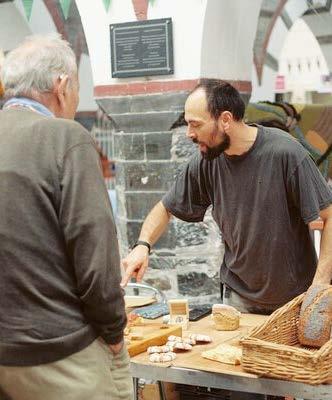
A nEW regular farmers market is bringing fresh, local produce and community spirit back to the heart of Cardigan.
Following the huge success of the pop-up market in September, which drew more than 2,000 visitors and featured 21 local producers, organisers have confirmed a twicemonthly market will now be held at the Guildhall, Pendre.
The next markets take place from 10:00am to 2:00pm on Friday, November 7, Friday, November 21, Friday, December 5, and Friday, December 19.
Each event will showcase a wide
range of local food producers selling bread, cheese, seasonal vegetables, meat, honey, preserves, and more, with live music from local performers adding to the atmosphere.
The market, organised by Ein Cegin and Ffynnon, aims to strengthen the local food system by supporting independent farmers and producers, ensuring fair prices for their goods, and helping more people buy locally.
Sophie Bennett of Ein Cegin and Cleo Williams of Ffynnon said: “The market has been a celebration of beautiful local food and the power of community. We want to help more people connect with local producers
and enjoy our brilliant and diverse local food system.”
Local producer Dee Butterly of Awen Organics Farm said the first event had been “just what Cardigan needs”
“There was a real buzz in the hall and it was wonderful to sell our produce directly to the community.”
Elin Jones of Caws Crugmawr added: “It is fantastic to have a local market that provides fresh, quality food to the people of Cardigan.”
For more information, contact 07450 429 814 or email eincegin@ gmail.com.



A greater focus on prevention and public health was called for this week to improve the long-term health of people across Wales.
ental Health and Wellbeing Minister Sarah Murphy urged healthcare professionals to become “champions of prevention”, encouraging people to make healthier choices and tackle the root causes of obesity and smoking.
Speaking at the Welsh Public Health Conference in
Cardiff on Wednesday (Oct 22), she highlighted the impact of preventable illnesses on people’s lives, the NHS and the wider economy.
Obesity-related illnesses currently cost the Welsh NHS £365 million a year, with a quarter of adults living with obesity. Smoking remains the leading cause of preventable death, responsible for around 3,845 deaths and 17,000 hospital admissions each year.
Minister Murphy said: “Whilst
there is a place for weight-loss jabs for some people as part of their weight management, they are not the solution for everyone.
“We must intervene earlier to address the underlying causes. That’s why our focus is on a whole-system approach to tackle obesity’s complex roots.”
The Welsh Government has already introduced a series of
preventative health policies, including:
• New laws restricting multi-buy offers on less healthy foods and keeping them away from key selling locations, due to come into force in 2026.
• Healthy Eating in Schools regulations, designed to improve access to nutritious meals and support universal free school meal programmes.
• Health Impact Assessments, requiring public bodies to show how their work supports the well-being goals of a healthier and more equal Wales.
• Wales’ commitment to becoming a Marmot Nation, to help tackle health inequalities.
• A national targeted lung cancer screening programme, set to begin in 2027.
Minister Murphy added: “Transforming health outcomes for the people of Wales cannot be achieved by government alone. We need everyone to play their part and become champions of prevention in everything they do.
“Prevention has the power to radically improve both public health and the economy. Every pound invested in early intervention can yield returns of up to £13 in reduced costs later.
“Together, we are building a Wales where everyone can thrive — where prevention is woven into every policy decision we make. The future of Welsh health depends on the actions we take today.”

ThE LATEST figures show nhS treatment waiting lists in Wales remain at 793,058 pathways –equivalent to nearly one in four people in the country.
While Wales continues to struggle, the gap with England is stark. More than 8,700 Welsh patients have now been waiting over two years for treatment, compared with just 168 in England – meaning patients in Wales are almost 500 times more likely to face a two-year delay.
The Labour First Minister, Eluned Morgan, previously promised to eliminate two-year waits by March 2023 and again by March 2024, but both deadlines were missed.
Welsh Conservative Shadow Health Minister James Evans MS said the figures show continued failure despite heavy public spending:
“It is completely unacceptable that patients are having to wait longer and that two-year waits are rising again

despite the increased investment of taxpayers’ money into the Welsh NHS.
“The
Welsh Conservatives will always prioritise our frontline NHS
staff and cutting those excessive waits. We will not waste money on more middle management, Welsh Government bureaucrats, or Labour and Plaid’s obsession with creating more politicians.”
According to the latest Welsh Government data, the median waiting time for treatment in Wales is now 21.7 weeks, compared with 13.4 weeks in England. In A&E, just 65.5% of patients were seen within four hours in September – well short of the 95% target – while 10,208 people waited 12 hours or more.
Cancer performance also remains below target, with 61.8% of patients starting treatment within 62 days, far short of the 75% goal.
The Welsh Conservatives say these figures reflect “a health system in crisis,” urging the Welsh Government to “focus on delivery, not political reform.”

hEALThCARE support workers at Swansea Bay university health Board – including several who live or commute from Pembrokeshire –will finally receive years of unpaid earnings after the board reversed its decision to delay compensation payments.
The move follows a long-running campaign led by UNISON Cymru/ Wales, representing the mainly female, low-paid workforce. Around 1,000 Band 2 healthcare support workers will now be upgraded to Band 3, with each receiving a lump-sum “recognition payment” covering years of underpayment.
Staff were left angry last month when the health board unexpectedly “paused” the deal despite promising that payments would be made before Christmas.
On Tuesday (Oct 21) more than thirty staff marched to the board’s headquarters to deliver a 2,000-signature petition demanding that Swansea Bay keep its word. Just fortyeight hours later, the board confirmed that payments would now go ahead in full.
The Herald understands that the turnaround followed direct intervention from the Welsh Government, which urged the health board to honour its
earlier commitment.
“A VICTORy FOR ThE LOW-PAID”
Tanya Bull, UNISON Cymru head of health, said: “Healthcare support workers in Swansea Bay have fought hard to be recognised and rewarded properly. They should be proud of this win and of forcing their employer to change course.
“This outcome was only possible thanks to significant intervention from the Welsh Government, without which it’s unclear whether Swansea Bay would have done the right thing.”
Lianne Owen, UNISON Cymru regional organiser, added: “I am very pleased that Swansea Bay Health Board has finally honoured its commitment. These staff can now continue providing excellent service to patients with confidence, knowing they are being properly valued and paid for the tireless work they do every day.”
Hollie Arnold, a healthcare support worker at Neath Port Talbot Hospital, said: “This is an absolute win for the hard-working healthcare support workers who have for too long gone above and beyond delivering high-class care and being underpaid for it.”
Tony Roberts, of Cefn Coed Hospital, described it as “a victory for the low-paid workers of the NHS”, while Melissa Lewis and Spencer Gibbs from Morriston Hospital said the long-awaited
payment would make for “a very happy Christmas”.
Under the NHS Agenda for Change pay structure, healthcare support workers are graded according to the complexity of their clinical duties.
Those on Band 2 typically earn around £22,400 a year, while Band 3 pays approximately £24,300 – a difference of nearly £2,000 annually, plus back pay dating back several years for those affected.
The affected workers had been performing clinical tasks such as patient observations, blood monitoring and ECG tests – duties normally associated with a higher grade.
UNISON argues that the successful rebanding at Swansea Bay sets a precedent for similar roles in other Welsh health boards, including Hywel Dda, which covers hospitals in Haverfordwest, Carmarthen and Aberystwyth.
Healthcare assistants from Pembrokeshire often work shifts in Swansea Bay hospitals under flexible contracts, meaning a number of local families are also set to benefit from the back pay.
Union officials say the outcome sends a clear message that support staff across Wales must be fairly recognised for their skills and responsibilities.


WELSh LABOuR leader
Eluned Morgan has admitted her party must “listen and learn” following a devastating defeat in the Caerphilly Senedd by-election, describing the result as “a by-election in the toughest of circumstances”.
The seat, once regarded as one of Labour’s safest in Wales, was captured by Plaid Cymru’s Lindsay Whittle, a veteran local councillor and former Senedd Member, who secured a decisive victory over Labour’s candidate Richard Tunnicliffe and pushed the party into an unprecedented third place behind Reform UK.
“WE TAkE OuR ShARE OF ThE RESPOnSIBILITy”
In a statement issued by Welsh Labour, Ms Morgan thanked Mr Tunnicliffe for standing “out of a desire to serve his community” and congratulated Mr Whittle on his win.
“This was a by-election in the toughest of circumstances, and in the midst of difficult headwinds nationally,” she said.
“Welsh Labour has heard the frustration on doorsteps in Caerphilly that the need to feel change in people’s lives has not
been quick enough. We take our share of the responsibility for this result. We are listening, we are learning the lessons, and we will come back stronger.”
COLLAPSE OF ThE LABOuR V ote
The Caerphilly result marks one of the sharpest drops in Labour’s vote share in Welsh political history. The party, which has held the constituency in one form or another for more than a century, secured just 11% of the vote, suffering a swing of 27 percentage points.
Plaid Cymru’s campaign, led by party leader Rhun ap Iorwerth, focused on offering what he called “a bold, inclusive vision” for Wales and a rejection of what he described as “Starmerite managerialism”. Reform UK also performed strongly, taking second place and highlighting the volatility of the political landscape ahead of next May’s council and Senedd elections.
The loss has sent shockwaves through both Cardiff Bay and Westminster,
with some Labour MPs warning that if similar results were repeated in next year’s elections, it could prove fatal to Keir Starmer’s leadership.
Although Welsh Labour remains the dominant force in devolved politics, the Caerphilly result has fuelled concerns that the party is losing ground among traditional workingclass voters in former industrial heartlands — once considered its core base.
The by-election was triggered by the resignation of former Labour MS Hefin David, who stepped down earlier this year.
Lindsay Whittle’s return to the Senedd marks a political comeback for one of Plaid Cymru’s most experienced figures. He previously represented South Wales East between 2011 and 2016 and served for decades on Caerphilly County Borough Council, including as its leader. His victory speech described the result as “a turning point for Welsh politics”, pledging to “stand up for the people of Caerphilly who have been taken for granted for too long”.

FORMER Welsh
Conservative leader Andrew RT Davies has said Plaid Cymru’s by-election victory in Caerphilly should serve as a “wake-up call” for those who believe in maintaining the union.
The result, which saw Plaid Cymru take the Senedd seat from Labour after more than a century of Labour dominance in the area, has sent shockwaves through Welsh politics. Mr Davies said the outcome demonstrated how “separatists” were gaining ground while unionist parties were failing to challenge them effectively.
Mr Davies said: “Separatism is corrosive, with the aim of breaking apart our nation and no regard to its consequences on the living standards of the people of Wales.
“Plaid have escaped the scrutiny subjected to other parties for too long, portraying themselves as a harmless protest vote while they pursue
their extreme ideology.
“The separatists’ victory in Caerphilly must be a wake-up call, and the onus is on those of us who believe in the Union to show the people of Wales the real Plaid.”
Plaid Cymru leader Rhun ap Iorwerth said the result showed that “voters have rejected Labour’s managerialism and embraced Plaid’s positive vision for Wales.” He described the victory as proof that “Labour’s century of dominance in Wales is over.”
A Labour spokesperson, meanwhile, said the party was “listening carefully” to voters after what they called a “disappointing result,” and would “redouble efforts to earn back trust in communities across Wales.”
The Caerphilly result has reignited debate about the future of the Union, with growing calls from both sides for a clearer national conversation on Wales’s constitutional direction.

A CALL for Pembrokeshire’s national park to once again financially contribute to the upkeep of 10 public toilets in the park, this time to the tune of just under £123,000 a year, has been backed.
being taken over by local town and community councils or – in the case of the 10 outlined – support from the national park could not be agreed.
contribution per toilet for any capital works, amounting to £142,986.38.
However, the park’s income working group has decided the £2,000 figure was “unreasonable given the very limited investment from PCC on facilities in the last two years,” instead recommending a further two years payment plus inflation without that element, resulting in a payment of some £122,986.38 per year.
It was also recommended more clarity be sought from PCC about the off-setting of any contribution against the income generated from some toilets which have a charging function, such as Saundersfoot and Newport Sands/ Traeth Mawr.
The report warned the park’s future financial outlook “is challenging as the impact of cumulative reductions in core funding together with significant cost rises is felt,” with the budget for 25-26 forecasting a deficit of £566,000 for the year, and deficits in excess of £1m are predicted for the next three financial years.
At the time there were fears, due to financial constraints, that some council-run public toilets could close if alternative sources of funding, including
Back in 2023, the park agreed to make a contribution of £111,000 a year, for two years, to fund toilet facilities at West Angle, Freshwater East, Manorbier, Newport Sands / Traeth Mawr, Poppit Sands, Saundersfoot, Broad Haven North, Solva, Little Haven and St Brides.
A report before members at the October 22 meeting of Pembrokeshire Coast National Park said, with the ending of the two-year period, Pembrokeshire County Council has now asked for a contribution including inflationary pressures, along with a £2,000
Members backed the recommendation for a further two years’ support for the 10 toilets from April 1 of next year, without the £2,000 contribution, with the caveat the contribution should specify that the running costs of Traeth Mawr/Newport Sands be revisited once improvement works have been undertaken, and that income generated at Saundersfoot and Traeth Mawr/Newport Sands be off-set against costs for these locations.
REPORTS that illegal migrants have been entering Britain through holyhead Port in Anglesey have prompted calls for stronger border security and renewed debate over Wales’ “nation of Sanctuary” policy.
South Wales Central MS and former Welsh Conservative Senedd Leader Andrew RT Davies said the revelation exposed flaws in the approach taken by Plaid Cymru and Labour, warning that their plan to make Wales a Nation of Sanctuary for asylum seekers could be acting as a “pull factor” for illegal migration.
Mr Davies, who chairs the Senedd’s Economy, Trade and Rural Affairs Committee, said:
“News that illegal migrants have been entering Britain through Holyhead Port is deeply concerning, and robust action is required to stamp it out.
“The message to those entering our country illegally must be clear: you are not welcome and will not be allowed to stay.
“Plaid and Labour’s Nation of Sanctuary does the opposite, acting as a pull factor encouraging more illegal migrants to come. It must be
scrapped.”
The UK Government retains responsibility for border security and immigration enforcement, including at Welsh ports such as Holyhead, Fishguard and Pembroke Dock. Both Pembrokeshire ferry ports operate routes to and from Ireland, which is part of the Common Travel Area – a long-standing agreement allowing passport-free movement between the UK and Ireland.
However, in recent years concerns have been raised about potential “backdoor” migration through Irish routes, particularly since the introduction of tougher controls on crossings in the English Channel.
Plaid Cymru and Labour argue that the Nation of Sanctuary policy is designed to ensure fairness and compassion for those legally seeking asylum, rather than to encourage illegal entry. Supporters say it reflects Welsh values of empathy and humanitarian responsibility.
The Home Office has not confirmed whether additional checks or resources will be deployed at Welsh ferry ports following the reports from Holyhead.


W ITH ANDREW LyE
Liberal Democrats are renewing calls for the Government to implement proper community policing as new statistics reveal an increase in shoplifting in the year ending june 2025. Shoplifting offences increased by 13% (to 529,994 offences) and theft from the person rose by 5% (to 145,860 offences) compared with the previous year.
The figures were revealed by the Office for National Statistics Centre for Crime and Justice, released earlier this morning.
The Liberal Democrats slammed the previous Conservative Government for the figures, arguing that years of ineffective resourcing have left local police forces overstretched, under-resourced and unable to focus on solving crimes like shoplifting.
The Party has also criticised Labour for failing to tackle the issue head on, despite their promise to invest in community policing and get tough on crime.
The Party is calling for a return to genuine community policing, starting with a ‘Police Counter Promise’, guaranteeing a staffed police desk in every community. Only then can public confidence be rebuilt, with a visible police presence focused on tackling the crimes that matter most to local people.
Commenting, Liberal Democrat Spokesperson for Justice, Jess BrownFuller MP said:
“This rising surge in shoplifting is becoming worryingly normalised. Frankly, our communities and our high streets deserve better than this. The Government has made big promises when it comes to tackling crime, but they are failing to deliver.
“The former Conservative government destroyed neighbourhood policing and left our
communities to pay the price. Now this Labour government has done nothing to change the course.
“The Liberal Democrats will keep fighting for a return to proper community policing, with more bobbies on the beat and a staffed police desk in every community. That’s how we keep neighbourhoods safe and cut crimes like shoplifting.”
This comes on top of shocking data from the Home Office that reveals a bike theft epidemic, with only 2% of criminals charged and a total of 86% of all bike thefts going unsolved last year.
The Liberal Democrats have said that bicycle theft is effectively ‘decriminalised’.
Almost two thirds of police forces in England & Wales had at least 80%+ of cases going unsolved. Of the 44 police forces, none had solved more than 55% of bike theft cases.
This comes as the British Transport Police have said that bike thefts outside London railway stations will not be investigated if they have been locked for more than two hours.
Max Wilkinson, Liberal Democrat Home Affairs Spokesperson, said:
“Every single day, thousands of victims are denied the justice they deserve - criminals are getting away scot free because bike theft has effectively been decriminalised.
“Things cannot continue like this. Our communities deserve to feel safeand that includes being confident that if you’re the victim of a crime, justice will be served.
“The Government cannot afford to dither and delay. They must crack down on unsolved crimes”.
Whatever happened to Tony Blair’s mantra, “Tough on crime. Tough on the causes of crime”?
If you have any issues or comments, please contact me at andrew.lye@pembslibdems.wales
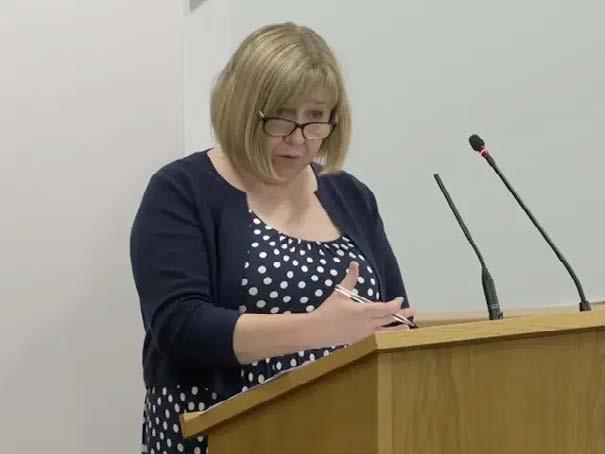
WALES’ education secretary has dismissed the Conservatives’ focus on the nation’s poor 2022 PISA scores, telling the Senedd it was “time to move on” from the worst-ever results.
Lynne Neagle accepted Wales needs to do better in the worldwide study of education systems as she accused the Conservatives of “harking back” to the record-low results.
In the 2022 cycle, which was delayed due to Covid, Wales’ scores decreased in mathematics, reading and science to the lowest since first taking part in 2006.
Blaming the pandemic, Ms Neagle told the Senedd it was “time to move on” – with 15-yearolds currently sitting the latest PISA tests which are held every three years.
She said: “I am disappointed by the relentless focus on challenges within the system, rather than ever taking the opportunity to celebrate achievements.”
Defending her record during a Tory debate on Wednesday (October 22), she celebrated a rise in school attendance as well as improvement in GCSE and A-level results.
But the Conservatives painted a far bleaker picture, accusing the Welsh Government of “systemic failure” with the lowest PISA scores in the UK for five consecutive cycles.
In a fiery opening speech, Natasha Asghar – the party’s shadow education secretary – warned the Labour Welsh Government had “failed our children” for “far too long”
“Classrooms are overcrowded, teachers are under ever-increasing pressure, school violence is through the roof and standards are
Campbell warned Wales is paying a painful price for “over 25 years of Labour failures”.
But he rejected the Conservatives’ proposed solutions, arguing Wales should not simply copy policies from England because education is devolved.
Laura Anne Jones, who defected to Reform UK, agreed with much of the Tory motion, warning the additional learning needs system was “fundamentally flawed”.
In her response to the debate, Ms Neagle set out the context of Wales’ PISA results.
slipping, whilst ministers just make excuses,” she said. Too many pupils are being left behind.”
Tom Giffard, a fellow Tory, criticised the call to “move on”, saying: “We look at the worst PISA results anywhere in the UK… yet we have a minister who says, ‘It’s time to move on’. It is a system that is fundamentally broken, with a minister who is absolutely complacent.”
The motion called on the Welsh Government to adopt a “zero-tolerance” approach to restore discipline, demanding the automatic exclusion of any pupil who brings a weapon into school.
Other proposals – which were also ultimately rejected by the Senedd – included establishing academy schools, following in England’s footsteps, and mandating the teaching of phonics.
The Conservatives were not the only party to attack Labour’s record. Plaid Cymru’s Cefin
She said: “This was a time when our learners and teachers were emerging from two years of the pandemic and all the challenges that caused, and a period when few learners were taking structured exams in the same way as previous PISA cohorts.”
The education secretary, who was appointed in March 2024, pointed to improvements in reading and numeracy made by primary schools last year.
She told Senedd members the Welsh Government would ensure the systemic teaching of phonics through a new £8m project and a new national body, Dysgu.
On behaviour, Ms Neagle pointed to progress following a summit in May with work under way on mobile phones in schools, exclusions and detentions.
She concluded by raising a report published by education inspectorate Estyn that day. “Today Estyn have published their interim annual report,” she said. “I am pleased with the positive messages that are emerging around wellbeing, learner engagement and how schools are supporting their learners with additional learning needs.”

‘
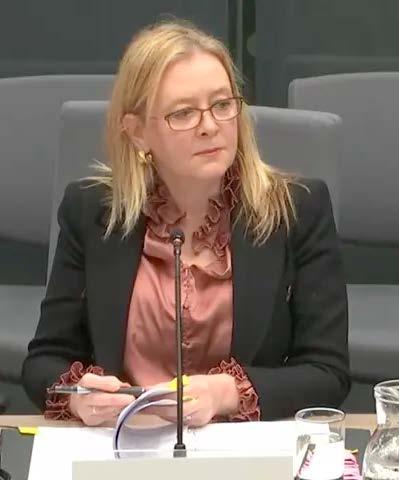
WALES’ housing secretary
jayne Bryant was bluntly told “you’re not listening” during a tense committee grilling over fears building safety reforms will “suppress” social housing supply.
Labour’s Lee Waters accused her of ignoring repeated, highlevel warnings from the sector about pushing through a bill that risks curtailing construction amid a “housing emergency”.
A tense exchange highlighted “profound disagreement” as the minister and her officials pinned the sector’s concerns on a “misunderstanding” of the building safety bill.
Warning of a lack of policy “join up”, Mr Waters pointed to evidence from the sector that the post-Grenfell reforms risk suppressing their ability to bring forward homes for social rent.
But Ms Bryant gave little ground, insisting the average costs would be low and the Welsh Government would not solve supply problems by “allowing people to live in unsafe homes”.
Mr Waters explained social landlords have warned the additional cost burden will affect their ability to borrow and the number of properties they can develop.
He asked: “Why are you so dismissive of that clear evidence from the sector?”
explaining a lower-risk third category with less onerous restrictions was added due to concerns about proportionality.
But Mr Waters suggested: “You’ve replaced one bad idea with another.”
He raised evidence from Trivallis housing association which warned of an extra regulatory burden and costs for lower-risk buildings already covered by fire risk assessments.
Pressed on whether the £100,000 figure is credible, official Steve Pomeroy said: “It’s not for me to say how they do business and what they think their costs are, but—”
Mr Waters cut in: “Well, it is for you to say. That’s the whole point of this session… we’ve had evidence, you’re saying it’s not right and you’re not telling us why.”
Mr Pomeroy, head of fire services in the Welsh Government, said: “I can’t personally see why there is £100,000 of extra cost there unless there is something that they are doing or not doing now that they maybe ought to be doing under the fire safety order.”
helping Get the housing Market and the Economy Moving – The abolition of Stamp Duty
At the start of the month, Leader of the Conservative party, Kemi Badenoch MP announced that the next UK Conservative Government will abolish stamp duty entirely on primary residences in England. It was a big policy which rightly attracted a lot of attention and following that announcement, the Leader of the Senedd Conservatives, Darren Millar MS confirmed that a future Welsh Conservative Government would abolish Land Transaction Tax (LTT), the equivalent tax in Wales on properties here too.
was a major barrier to that.
Now some have expressed concerns that abolishing stamp duty could lead to an increase in house prices, citing the temporary stamp duty relief introduced following the Covid-19 lockdowns as an example. However, our proposal involves a permanent removal of the tax, not a short-term holiday and we believe that the long-term economic effects would be fundamentally different, offering greater stability and predictability for homebuyers.
Ms Bryant pushed back, stating the Welsh Government speaks to the sector regularly as she gave evidence to the Senedd’s housing scrutiny committee.
But her Labour colleague replied: “With respect, that’s not my question. I don’t doubt you’re talking to the sector. The sector has given evidence to this committee that says very clearly this will suppress their ability to bring forward investment and you are not addressing that.”
Ms Bryant argued social housing supply is being addressed through other policy levers, saying: “I’m very happy to listen to them, but I do not think—”
Mr Waters interjected: “Well, you’re not listening to them, with respect, because we’re telling you what their evidence is and you’re not engaging with it.”
He pointed to evidence from Community Housing Cymru, which warned it would cost one housing association £100,000 a year to do fire assessments for lower-risk buildings.
The former minister asked: “Why are you still insisting that the costs are trivial?”
Ms Bryant denied she was dismissing the costs as trivial,
Mr Waters criticised the “awfully casual” accusation, with Mr Pomeroy rowing back on his suggestion that Trivallis is breaking the law. “We have no evidence to that effect,” he said.
Tania Nicholson, deputy director for housing quality, pledged to pick the issue up with Trivallis to ensure “absolute clarity” in terms of expectations under the bill.
Mr Waters said: “With respect, this is the consistent answer: ‘We’re talking to the sector. We’re listening to the sector’. But you’re not, are you?”
Ms Nicholson added: “I think there’s probably some misunderstanding in terms of the expectations under the bill and the current arrangements.”
But Mr Waters was dissatisfied: “You can’t expect us to pass a law of this gravity on the basis that there are some problems and, ‘We’ll sort it out; we’re talking to them’.
“This is law. We can’t put into law things that are going to make things worse and you’re not giving us any good reason not to.”
During the fiery exchange on Wednesday (October 22), the Labour politician concluded: “It seems there are klaxons being sounded by the sector here that the Welsh Government appears deaf to – I’m really troubled by it.”
We believe that abolishing stamp duty would significantly ease the path to home ownership for millions of people. Stamp duty is a substantial financial barrier for prospective buyers, and its removal would help unlock opportunities for individuals and families to purchase their own homes. By eliminating this outdated tax, my colleagues and I are trying to make the housing market more accessible and equitable for all.
Reaction to the policy from the industry has been, on the whole, very positive. The Institute of Economic Affairs has said, “abolishing stamp duty is the single best reform any government could make to Britain’s tax system. As things stand, this outdated and uneconomic levy is wreaking havoc on our already troubled housing market – by deterring sales and depressing housebuilding.”
The HomeOwners Alliance has also highlighted that abolishing stamp duty would provide extra mobility for those looking to relocate or downsize. Their research shows over 800,000 homeowners have shelved moving plans in the past two years, and stamp duty
And here in Wales, the market needs support. The latest figures from the 2021 census for Wales indicates that only 66.4% of households owned their accommodation and that needs to change.
Readers, it’s a fundamental Conservative principle to empower individuals to own their own property – because a house is more than just a home. It’s a statement of personal responsibility and independence too. The Conservative party has a long history of supporting people to buy their own home – Stanley Baldwin’s second Conservative Government oversaw a huge expansion of house building and Lady Thatcher of course, introduced the Right to Buy scheme in the 1980s. We may be in a different age, but the principle is the same and Kemi Badenoch and Darren Millar are right to focus on removing barriers to homeownership and ensuring everyone can have the right to own their own home.

SEND yOUR LETTERS TO: THE EDITOR, 11 HAMILTON TERRACE, MILFORD HAVEN, PEMBROKESHIRE, SA73 3AL
EMAIL US AT: editor@herald.email


A Mouth Full of Salt.
SHELTERBOx BOOK CLUB
In a world full of uncertainty, stories can connect us, inspire us, and even help rebuild lives.
A growing community of readers is turning their love of books into real-world impact, helping families recover from disaster, one story at a time.
At the ShelterBox Book Club, our community is one built on compassion, curiosity, and a shared belief that stories can change the world. Our members have raised over £1.5 million, supporting people who’ve lost their homes to conflict, earthquakes, and other disasters with emergency shelter and essential aid.
For a monthly donation, members receive a hand-picked book every six weeks, each chosen to reflect the lives and cultures of the people ShelterBox supports. They can dive deeper into the stories too, connecting with fellow readers through online forums and author events.
As tents arrived in Gaza, readers explored Before the Queen Falls Asleep by Huzama Habayeb. After the earthquake in Myanmar, they read Latitudes of Longing by Shubhangi Swarup. And while ShelterBox responded to displacement in Sudan, members were immersed in Reem Gaafar’s
It’s more than just reading. It’s about connection, empathy, purpose – and windows into worlds many of us may never experience.
In a time when over 123 million people are without a permanent home, this is a simple way to be part of something bigger.
To find out more or become a member, visit shelterbox.org/bookclub.
Catherine Thornhill head Bookworm at ShelterBox
Today, while attending my local hospital for a flu jab, I noticed a sign on the wall reminding us of one of the great enduring truths upon which the nhS was founded in 1948 — by the Labour and Liberal parties — that in taking steps to preserve our own health, such as through vaccination, we also take the most effective action to protect the health of every other person on the planet. We are interdependent.
This is not merely a sentimental notion, but a proven and universal truth — one revealed through centuries of scientific and ethical discovery. Through the dedication of great minds, both material and
n. Westerman
When I first became entitled to vote, it was in the shadow of a war in which forty million people died to defeat the hard-right ideologies that had taken root across the world. Beyond Conservatism and Republicanism lay something darker — the poisonous beliefs of the ku klux klan, Fascism, Racism, and, at its most evil, nazism. Entire nations followed Germany into that abyss, consumed by hatred so deep it led to the murder of six million jewish men, women, and children.
abstract truths have been passed down from the universe itself to humankind, the most advanced of all mammals on this planet — a planet 13.7 billion years in the making. The design of this universe, as we can see it so far, teaches a clear lesson: we are meant to care deeply for others.
After four billion years of life evolving on Earth, we should have learned this lesson well. Family life, devotion, and sacrifice — values seen in all mammals — have evolved into ethical principles of the common good, championed by Puritans and Roundheads in the seventeenth century, and by social reformers in the nineteenth, who fought for democracy, universal education, and social protection through pensions and unemployment benefits. Every one of these advances was opposed by Conservatives in their day — in 1870, in 1909, and again with the founding of the NHS in 1948. Yet each represented another step in our ethical evolution.
I have never understood why Conservative and Reform parties continue to resist the proven design of this universe — one built on cooperation, compassion, and interdependence. When former Prime Minister David Cameron introduced policies denying support to a family’s third child, I could not help but ask: what species would make such a choice? No mammal on Earth would abandon its young. Why, then, would any adult human do so?
Today, much of the media reports that politicians are viewed as dishonest and untrustworthy. But I believe the problem runs deeper: that many of today’s voters, in Britain and elsewhere, have forgotten the moral principles of their grandparents — men and women who crossed the globe to give their lives for others.
The rise of far-right movements such as Reform reflects a return to the same poisonous attitudes — racism and hatred — that those earlier generations died to defeat. Such beliefs are subhuman, denying the family love, devotion, and sacrifice that even animals display, and defying the very moral order of the universe.
Our society’s worship of money, treating wealth as the measure of a human life, is a betrayal of those ideals. The greed, selfishness, and arrogance of capitalism were all foreseen in the New Testament, but still self-interest rules the minds of the modern right, shutting out reason and compassion.
For over a century we have known that money is not the only currency. No billionaire can buy a pint of donated blood to save his own life. Yet only around four percent of British adults give blood — a simple, risk-free act of generosity. What does that say about the other ninety- six percent, and the example they set for their children?
They will live their lives without ever discovering what it truly means to believe in something worth living for.
n ame and address supplied



P EACEF u LLy on 7th October. Loved and missed by Sue. Loving father to Rupert, father-in-law to Lara, proud granddad and art tutor to Mia and Bella.
Funeral service on Thursday 13th November at Parc Gwyn Crematorium, Narberth at 11.30am.
Family flowers only please.
Donations in lieu, if desired, to Tackling Minds c/o Paul Jenkins & Sons, Funeral Directors, Feidr Castell, Fishguard, SA65 9BB. Tel01348 873250.
P EACEF u LLy at Withybush h ospital on Thursday 16th October, Martin of Croesgoch.
Beloved husband of Carolyn, loving father of Kathryn and Danielle, treasured grandfather of Ethan, Isaac and Ronnie, a dear brother and brother-in-law of Huw & Gwawr, Ann & David.
Public funeral service on Saturday 8th November at Croesgoch Chapel at 10am followed by cremation at Parc Gwyn, Narberth at 12:15pm.
Family flowers only. Donations in lieu if desired, made payable to ‘CDU Withybush Hospital’ c/o Paul Jenkins & Sons Funeral Directors, Feidr Castell, Fishguard, SA65 9BB. Tel:
01348 873250.
P EACEF u LLy on Tuesday 14th October, Martin of Goodwick.
Wonderful son of Angela and the late Elwyn, devoted brother of Ian, Liz and Julie, a loving uncle and great uncle.
Funeral service on Friday 7th November at the Chapel of Rest, Feidr Castell, Fishguard at 1pm followed by interment at St Mary’s Churchyard, Manorowen.
Further enquiries to Paul Jenkins & Sons Funeral Directors, Fishguard. Tel: 01348 873250.
tH e death occurred peacefully at Morriston h ospital on Tuesday 14th October of Mrs Mary Elizabeth Frances j ane Lewis, affectionately known as ‘Mary’ aged 88 years of Sunny Bank Farm, Stepaside.
Beloved Wife of the late Alwyn. Cherished Mum to Valerie, John, Keith, Susan, Steven, Mark, Melanie and Martyn. Much Loved Mother-in-law. Devoted Nannie to her 17 Grandchildren, 18 Great Grandchildren and 5 Great-Great Grandchildren. Treasured Sister and Aunt.
The funeral service will take place on Thursday 6th November at Parc Gwyn Crematorium, Narberth at
3.15pm.
There will be family flowers only with donations for The Paul Sartori Foundation c/o E. C. Thomas and Son, Zoar Chapel Funeral Home, Llanteg, Narberth SA67 8QH (01834) 831876 and 21 Main Street, Pembroke SA71 4JS (01646) 682680 or via www. ecthomasandson.co.uk
tH e death occurred peacefully at Withybush h ospital on Wednesday 9th October 2025 of Mrs. Dorothy
Griffiths, aged 80 years of Milton. Beloved Wife of the late Ormond. Dearly loved Mum of the late Mark. The funeral service will take place on Friday 14th November 2025 at St. Mary’s Church, Carew Cheriton at 2.00pm followed by interment in the Church Cemetery.
Donations in lieu of flowers for Wales Air Ambulance c/o E. C. Thomas and Son, Zoar Chapel Funeral Home, Llanteg, Narberth SA67 8QH (01834) 831876 and 21 Main Street, Pembroke SA71 4JS (01646) 682680 or via www.ecthomasandson.co.uk





















GARDENING AND





RECLAIMED BUILDING MATERIAL

RUBBISH AND WASTE REMOVAL


PROFESSIONAL CAR WASH

PODIATRy

SCRAP METAL

SHUTTERS & BLINDS

STORAGE TANKS

SOUND LIGHT AND STAGE

TECHNOLOGy AND COMPUTERS

TRAILERS

VEHICLE RECOVERy











MPs are preparing to quiz the Welsh Rugby union (WRu) over the outcome of its recent consultation and the wider implications for the sport’s economic and cultural significance across Wales.
“With rugby woven into the fabric of life in communities up and down the nation, the proposed structural changes announced by the WRU today will resonate far beyond the pitch,” said Ruth Jones MP, chair of the Welsh Affairs Committee.
For supporters, however, the pressing questions remain: which team will be cut, and when will this take effect?
The WRU initially proposed reducing the number of regions by two, responding to unanimous calls for reform. Yet the fierce backlash made it clear that such a drastic measure was politically and culturally unpalatable. Nevertheless, one team is still expected to go.
All indications suggest a direct contest between the Ospreys and Scarlets, the two most successful clubs since the regional rugby era began in 2003, for a single west Wales spot. There is hope within the governing body that the clubs could merge—a scenario almost realised in 2019. Such a combination would create a formidable team but would require considerable diplomacy—or perhaps a measure of desperation.
Both clubs’ funding agreements with the WRU run until June 2027, but it is widely believed that a decision on the future structure will be made well before that date.
The WRU has remained non-committal regarding its obligations to maintain four Welsh teams in the United Rugby

Championship (URC), though organisers have emphasised the importance of an even number of Welsh teams to preserve the competition’s structure.
Financial considerations add another layer of complexity. The WRU could be liable for compensation if a team is withdrawn prematurely. Talks are already underway on options for a 15-team league or determining which club could occupy the final slot should the league remain at 16.
International factors may also influence the decision. South African stakeholders
reportedly oppose proposals to invite a club from the United States or Canada, citing travel concerns. This has prompted speculation about alternative European options—possibly clubs from Georgia, Spain, or Portugal—or even a side from the English Championship.
For Welsh rugby fans, the coming months promise uncertainty and intense debate, as the WRU navigates a delicate balance between financial realities, cultural traditions, and the future competitiveness of the sport in Wales.

cymru football star Aaron Ramsey has increased the reward for information about his missing dog, halo, to $20,000 (£15,000).
The former Arsenal and Cardiff midfielder, who now plays for Pumas UNAM in Mexico City, said Halo was last seen in San Miguel de Allende, in the central Mexican state of Guanajuato.
The beagle went missing on 9 October while wearing a dog tracker collar, and Ramsey shared a Google Maps location of her last known whereabouts.
“Any news about our Halo please contact us. Big reward for finding her. We are all praying she’s ok and can be back with us soon,” he wrote on Instagram.
Ramsey first announced Halo’s
disappearance two weeks ago and has since posted several photos of the beloved pet on social media. Initially, a $10,000 reward was offered, but after a week with no leads, the footballer and his family doubled the amount.
“We just want our girl back,” he added in another social media plea, referring to the 10-year-old dog.
The most recent Instagram post shows a black-and-white photograph of Halo snoozing with her head resting in the crook of Ramsey’s arm, captioned: “What I’d do to hold you one last time Halo.”
Ramsey has also shared a message from his wife, Colleen, expressing concern over the circumstances of Halo’s disappearance. She said the family has some “serious questions” and fear they “may never get answers.”
“We still haven’t found Halo. I don’t think we ever will,” her post read.Ramsey, the Wales captain, joined Mexican topflight side Pumas UNAM earlier this year, making his Liga MX debut in August. The Caerphilly-born midfielder is the first high-profile British player to feature in the Mexican league.

k ILGETT y AFC are celebrating the continued generosity of local business h ughes Locks, which has sponsored the club for the past four years.
Owner Bryn Hughes has gone above and beyond his role as sponsor. Last season, he served as assistant coach for the under-8s mixed team, and this year he has stepped up
again — completing FAW training to become under-9s team coach and First Aider. Bryn now works alongside coaches Darren Rossiter and Dylan Edwards, who all dedicate their time to developing the young players’ skills and confidence. Bryn has even taken on the extra task of marking out the club’s mini pitch each week.
This season, Hughes Locks also funded a brand-new kit for the under-9s mixed team. The players themselves chose the design — a striking pink strip that has quickly become a source of pride and identity for the youngsters.
Bryn said: “It’s all about making the boys feel good, play with pride, and enjoy every minute of the game.”
Kilgetty AFC has thanked Bryn and Hughes Locks for their continued sponsorship, as well as Darren and Dylan for their enthusiasm and commitment to grassroots football. The club says the partnership with Hughes Locks reflects the strong community values at the heart of Kilgetty AFC’s success and growth.
WELSh rugby’s community game has been thrown into turmoil after 18 cup fixtures were decided by walkover on the same weekend, reigniting debate about the state of grassroots participation across the country.
The disruption, spanning from Division 1 down to Division 5, saw clubs unable to raise teams for scheduled Welsh Rugby Union (WRU) Cup matches, leaving opponents to progress automatically. The scale of the withdrawals has prompted fresh questions about player numbers, travel demands and the long-term health of the community game.
CLuBS STRuGGLE TO FIELD sides
The worst-affected competition was the WRU Division 2 Cup, where eight fixtures failed to take place. Aberaeron, Caldicot, Cymry Caerdydd, Morriston, Pontarddulais, Usk and Wattstown all advanced without playing after their
opponents — Croesyceiliog, Loughor, Senghenydd, Nantgaredig, Betws, South Gower and Whitland — could not fulfil their fixtures.
Elsewhere, Caerphilly moved through in the Division 1 Cup when Welshpool were unable to travel, while the Division 3 Cup saw Maesteg Celtic, Neyland, Resolven, Tonna and Tumble handed free passes following similar withdrawals.
In the lower divisions, Pontyclun and Whitehead advanced in Division 4, and Bargoed Athletic, Brecon Athletic and Pwllheli Athletic went through in Division 5.
It marks the second consecutive year that the WRU’s cup competitions have been hit by mass cancellations — twenty ties were lost to walkovers at the same stage last season.
Many clubs blame a combination of player shortages, injuries, and travel costs, with smaller squads

struggling to sustain full fixtures deep into the autumn. Some have arranged friendlies to keep players active, but critics warn that repeated forfeitures undermine the credibility of the competitions.
With participation numbers continuing to fall in some regions, there are growing calls for the WRU
to review its structure and scheduling, amid fears that the traditional cup format could soon become unsustainable.
As one former community coach told The Herald: “It’s not just a oneoff — this is the new normal unless something changes.”
H aV erford W est county staged a thrilling late comeback to earn a valuable 3–3 draw away at Connah’s q uay n omads on Saturday (Oct 25).
The Bluebirds looked dead and buried after falling three goals behind just after the hour mark, but a spirited fightback in the closing stages saw them snatch a point in one of the most dramatic finishes of the JD Cymru Premier season so far.
The hosts were dominant in the first half and took the lead in the 13th minute through Declan Poole. Jacob Cook doubled the advantage shortly before the half-hour, leaving County with work to do as they went in 2–0 down at the break.
Connah’s Quay continued to press after the restart, and Greg Walters made it 3–0 on 53 minutes, seemingly putting the game beyond reach.
HaV erford W est ra LLy L ate
However, Haverfordwest refused to give up. Dan Cowan sparked hope for the visitors with a well-taken goal in the 76th minute, before captain Dylan Rees struck again ten minutes later to make it 3–2 and set up a tense finale.
Pic by Nik Mesney/FAW

The Bluebirds kept pushing forward, and their persistence was rewarded in stoppage time when they found the equaliser to complete an unlikely comeback and send the travelling supporters wild.
A POI n T EAR n ED T h RO u G
The result was a testament to County’s fighting spirit, turning what
looked like certain defeat into a morale-boosting draw.
A club spokesperson said: “Late drama in north Wales, as the Bluebirds dug deep and scored twice in the closing stages to earn a valuable point on our travels. Thank you to everyone who made the long trip north — we’ll see you back at the Ogi Bridge Meadow next Saturday.” Haverfordwest will now look to build on the performance when they return home for their next JD Cymru Premier fixture.
PRIMARy school pupils with Additional Learning needs enjoyed some friendly competition this month as Sport Pembrokeshire hosted north and south Boccia tournaments – both sponsored by Valero.
More than seventy pupils from Learning Resource Centres across the county took part in the inclusive events, which gave children the chance to compete in the Paralympic sport that challenges players to propel a ball as close as possible to a smaller ‘jack’ ball.
At the south tournament, held at Tenby Leisure Centre, pupils from Tenby VC, Neyland Community School, Monkton Priory CP School, Pembroke Dock Community School and Gelliswick VC School took part. The final between Tenby and Monkton saw Tenby VC School emerge as winners.
The north tournament took place at Fishguard Leisure Centre, where Glannau Gwaun, Johnston CP School, Waldo Williams and Fenton CP School competed. The final between Johnston and Glannau Gwaun was won by the Fishguard school.

Jon Rowles from Sport Pembrokeshire said: “All the pupils thoroughly enjoyed the competition and showed great skill and sportsmanship throughout. Thank you to our Sport
Pembrokeshire Young Ambassadors from Greenhill School and Ysgol Bro Gwaun for umpiring so magnificently, and to Valero for its continuing support. It was a fantastic event for all involved.”
Support on the day came from Welsh international Boccia player Sian Jones and her family, along with dedicated volunteers from Saundersfoot Rotary’s Tenderfoot Disability Sports group.




